
The global authority in superyachting
- NEWSLETTERS
- Yachts Home
- The Superyacht Directory
- Yacht Reports
- Brokerage News
- The largest yachts in the world
- The Register
- Yacht Advice
- Yacht Design
- 12m to 24m yachts
- Monaco Yacht Show
- Builder Directory
- Designer Directory
- Interior Design Directory
- Naval Architect Directory
- Yachts for sale home
- Motor yachts
- Sailing yachts
- Explorer yachts
- Classic yachts
- Sale Broker Directory
- Charter Home
- Yachts for Charter
- Charter Destinations
- Charter Broker Directory
- Destinations Home
- Mediterranean
- South Pacific
- Rest of the World
- Boat Life Home
- Owners' Experiences
- Interiors Suppliers
- Owners' Club
- Captains' Club
- BOAT Showcase
- Boat Presents
- Events Home
- World Superyacht Awards
- Superyacht Design Festival
- Design and Innovation Awards
- Young Designer of the Year Award
- Artistry and Craft Awards
- Explorer Yachts Summit
- Ocean Talks
- The Ocean Awards
- BOAT Connect
- Between the bays
- Golf Invitational
- Boat Pro Home
- Pricing Plan
- Superyacht Insight
- Product Features
- Premium Content
- Testimonials
- Global Order Book
- Tenders & Equipment

Advances in superyacht hybrid power systems
While hybrid power systems haven’t yet met with widespread acceptance in the yachting industry, a new system from Northern Lights coupled with battery improvements may mean the next generation of yachts will be able to incorporate truly useful hybrid power technology.
Losing electrical power on a large yacht, even when off charter, can be much more than a temporary inconvenience. A steady flow of clean electricity at the correct voltage and frequency is of critical importance to modern communications and control systems. And an unplanned loss of electrical power may create the first link in a chain of seemingly unrelated equipment problems that might not manifest themselves until days, weeks or even months after power is restored.
An unplanned loss of electrical power may create the first link in a chain of seemingly unrelated equipment problems
Electrical power is affected by all of the consumers on the distribution system. Starting and stopping heavy loads such as stabilizer pumps, air-conditioning compressors and some laundry equipment can cause large momentary changes in voltage and frequency to create what electrical engineers call ‘dirty power’. This is the source of many unexplained problems with a yacht’s electronic equipment.
Battery power
Electrical power generation and distribution on large yachts seems to be as much art as science. Even if a yacht is delivered with generator capacity perfectly matched to demand, normal alterations and refits often increase and occasionally even decrease power requirements to the point where one generator is marginally capable of handling the load, but placing a second unit online means both are significantly underloaded. Overloading a single generator is unacceptable at any time, but engineers and owners are beginning to understand that underloading can be equally costly.
Recent improvements in storage battery technology related to the development of hybrid power systems for the automotive industry have created a shadow market for marine hybrid propulsion systems. But to date, very few hybrid marine power systems have met with widespread acceptance, partially due to high initial cost and limited performance.
Very few hybrid marine power systems have met with widespread acceptance, partially due to high initial cost and limited performance
The 2011 introduction of a marine version of the highly successful BAE Systems’ HybriDrive terrestrial drive system by Northern Lights, the Seattle-based manufacturer best known in the yacht market for its marine generator products, may provide a glimpse into the future of superyacht electrical power. How successful it will be for propulsion remains to be seen, but the technology it incorporates should have a far-reaching influence in future yacht designs.
Called the Northern Lights Hybrid Marine system, it utilizes a diesel engine to drive a generator that supplies electricity to a propulsion motor. If the power required to drive the yacht is less than that available, excess power is stored in a battery until needed.
That description is accurate as far as turning a propeller is concerned but ignores several features that might lead designers down a completely different path with regard to electrical power generation and distribution on large yachts.
The system is unique among its current competitors in that it does not transmit mechanical power from the engine to the propeller shaft. This means that the diesel engine and its attached generator can be mounted where and how they best fit.
So far, none of this is much different than diesel-electric propulsion systems that have been used to drive ships for over a century and, at first glance, is identical to the system used to power World War II submarines.
As in those submarines, diesel engines produce electricity to power an electric drive motor and charge batteries. When the engines are shut down, energy stored in batteries is used to power the motors. What sets Northern Lights’ system apart from similar offerings, and should make it much more interesting to designers is that the generator produces alternating current (AC) that is rectified to direct current (DC) to charge the battery, while DC power from the battery is converted back to AC to power the motor.
At first glance, it is identical to the system used to power World War II submarines
While this might sound like an energy wasting exercise, it is if we only consider propulsion. The potential to scale up the storage side of the system and extract electrical power for use on the yacht’s power grid more than offsets the losses inherent in a marine propulsion-only installation.
A large component of storage battery performance is based on the chemical reactions that either produce electricity under load or reverse to store electricity when undergoing a charge.
A battery’s suitability for use in a marine propulsion or power system is determined by it’s cost, and the battery’s performance. The latter’s factors include:
- The amount of power that can be stored,
- How quickly that power can be extracted and replaced,
- How many times that cycle can be repeated, and
- How large and heavy a battery is related to the amount of power it stores.
If we use the familiar lead-acid storage battery as a baseline measure of performance, the potential benefits offered by development of lightweight and high-power lithium-ion batteries become clear.
Breaking battery limits
A lead-acid battery will provide about 180 watts per kilogram. If the battery is discharged down to about half its capacity or depth of discharge, it might accept up to 800 recharges before its capacity drops too low to be useful. A storage battery’s useful life is considered finished when its capacity drops to 80 per cent of that of a new battery.
The latest lithium-ion battery technology will deliver about 2,400 watts per kilogram and has a useful life approaching 3,500 charge/discharge cycles.
Attempts to market hybrid power in the marine market seems to miss the areas which would benefit the most
The heart of the HybriDrive system is a Nanophosphate (lithium iron phosphate) battery developed by Waltham, Massachusetts-based A123 Systems. The performance of any storage battery is related to the surface area of its active components: the plates and the electrolyte. That is why a large battery can supply a lot more energy than a small battery that uses the same chemistry.
When scientists discovered the means to ‘nano-ise’ the phosphate material used in the cathode (the positive plate) they were able to exponentially increase the active surface area and create a storage battery with a capacity and lifespan never thought possible just a few years ago. A123 Systems claims its latest Nanophosphate batteries have a lifespan of approximately 10,000 charge/discharge cycles.
Thanks to the efforts of automotive and utility power engineers, hybrid power systems are quickly becoming a robust and highly efficient means to supply electrical power on the road and in the home.
Attempts to market hybrid power in the marine market seems to miss the areas which would benefit the most: electrical power generation and distribution.
The same technology that keeps the lights on in Fairbanks should be used to reduce the costs and environmental impact of the yacht industry.
More stories
Most popular, from our partners, sponsored listings.
Sustainable Yachting Evolution
Power Systems & Fuels
The yachts of the future and the new power systems.
In the context of green yachts, power systems and fuels refer to the methods and technologies used to generate the energy required to power the vessel. One example of a power system commonly used on green yachts is solar power. Photovoltaic (PV) panels can be installed on the deck or superstructure of the yacht to convert sunlight into electricity. Another example is wind power, where wind turbines are mounted on the yacht to generate electricity.
Another popular power system on green yachts is hybrid power, which combines two or more sources of energy, such as solar and wind power or solar and diesel generators. Hybrid systems can provide more reliable and efficient power, as they can switch between sources depending on the available conditions.
For fuel, the most widely used alternative is electric power where the energy storage system like batteries or hydrogen fuel cells are used. This allows for the use of clean, renewable energy sources, such as solar or wind power, to be stored and used as needed, instead of relying on fossil fuels like diesel or petrol. These yachts are quieter and less polluting compare to fossil-fueled counterparts. Additionally, the use of electric motors and propulsion systems can significantly reduce the yachts’ emissions and noise.
Yachts currently sail and meet the energy needs on board through the use of fossil fuels, mainly diesel fuel. Lately many yachts are introducing hybrid propulsion solutions (diesel – electric), but fossil fuel is not the only possible solution; hydrogen , DME and vegetable/bio fuels are a real possibility, the future is already available.
Our team, supported by international experts in the sector, proposes alternative low-emission power systems to be used onboard new yachts or converting existing marine diesel engines.

- Expedition Yachts
- Expedition Catamarans
- Bering Marine
- Bering Fleet
Hybrid propulsion system
In recent years and decades, yachting technology has advanced at an incredible rate and there is no doubt that some of the most exciting developments have been around hybrid propulsion. With a growing desire to protect our world and oceans, the use of hybrid technology is an exciting solution to developing luxury yachts that have the lowest environmental footprint, along with many other appealing benefits.
As more and more hybrid yachts and concepts are coming to market – including the options available from Bering Yachts – hybrid-powered yachts are increasingly proving to be a popular choice for forward-thinking yacht owners. The subject of hybrid propulsion is a fascinating one, that could cover many pages, but here we summarize key points of note. For those interested in learning even more than we have addressed in the following article the expert Bering Yachts team is on hand to discuss in detail the possibilities that hybrid can offer, together with the pros and cons. Want to learn more about hybrid yachts? Continue reading below:
What is the history of hybrid propulsion?
Hybrid propulsion in yachting has its origins in the 20th century, with some iterations of its usage seen as far back as one hundred years ago. However, it is only in recent decades that the idea of “Green Yachting” has become better understood and more widely applied in a luxury yacht setting. It is also worth noting that this technology is still very much evolving, even now, with new and more efficient systems constantly being developed. Most particularly noteworthy advancements are around battery systems, their capacity, and capabilities.
Key projects in the evolutionary process of hybrid superyachts included 96-metre Limitless, launched by Lürssen in 1997. But, it was the launch of the 58-meter sailing yacht Ethereal from Royal Huisman in 2009 that really caught the attention of the yachting world. Hailed as the world’s first true hybrid superyacht, Ethereal was the brainchild of discerning owners who were determined to create an energy-efficient and environmentally responsible sailing yacht, drawing on all the available technology at the time to do so. The 2015 83.5-meter Savannah, which launched from Feadship in 2015 was another significant milestone, with a pioneering hybrid propulsion package installed. The yard reported that Savannah’s five-option propulsion system delivered significantly reduced emissions together with a 30% fuel saving when compared to similar non-hybrid vessels.
Today, more and more hybrid superyachts are being launched and offered, with hybrid yachts of note including the one-of-a-kind 142.81-metre Sailing Yacht A, 50-metre HOME and 50-metre Electra from Heesen, 43-metre Canova from Baltic Yachts and 80m Artefact from Nobiskrug.
But what exactly is hybrid propulsion technology?
Put simply, hybrid propulsion technology is the use of two (or more) different energy sources to power a yacht, with the traditional engine source being supplemented by another source. Most often this means the use of a combination of diesel and electric systems. These power sources can then either be used individually or in conjunction with each other depending on the system installed. Hybrid propulsion technology is applicable on both sail and motor yachts and is optimized to suit the vessel in question to deliver the best and most efficient results.
The Details
Traditionally yachts are powered by a combustion engine that is powered by fuel. By contrast, a fully electric propulsion system makes use of a battery-powered motor. A hybrid propulsion system will feature a variable combination of a combustion engine, generators, battery packs and electric motors, dependent on the system. There are two primary types of hybrid systems: serial and parallel. Key differences between these two systems are in the relationship between the propeller and the engine.
Serial Hybrid System: This is where the main power source is an electric motor that is supplied by batteries, with an engine-driven generator on board to charge the batteries. When charged the electric motor will power the yacht, with the combustion engine shutting down. In a serial system, the engine and driveshaft are not mechanically connected. Often there will be the option for charging to also be powered by solar power, wind power, or shore power.
Parallel Hybrid System: This more versatile set up offers multiple options for operations, allowing users to easily switch between propulsion modes (whether electric or combustion engine). Unlike the serial set up, in a parallel system, the engine and driveshaft are connected directly, with the electric motor working on the same driveshaft. With this system, the traditional engine set up remains for when long periods of operations are required. The electric system can then be used as needed, dependent on the setting/conditions/requirements, with both systems able to work in parallel.
Because it is not directly connected to the propeller shaft, a serial system’s generator/electric motor must be able to handle the highest propulsion levels that the boat can achieve and is subsequently more powerful than a parallel system. While a serial hybrid system delivers clear improvements in efficiency (versus a conventional system) when operating at higher/optimum speeds, this set up can also mean situations where efficiency benefits of the hybrid system are potentially reduced when being used in low-speed operations such as harbor maneuvering.
In contrast, the electric elements of a parallel system need not operate at such high propulsion levels. The standard engine can be used for higher levels, while the electric motor will usually be used for when low to moderate speeds are required. The traditional engine will usually put to use for higher speeds and/or when the batteries are depleted, meaning that the most efficient form of operations is instigated as needed.
Which system to use, and the power levels, ranges, and efficiencies that are possible will depend on a number of variables including the type and use of the yacht, and owner preference. Whatever the type of system in use, the end goal is to deliver the most efficient operations possible, making use of all systems and of available electrical energy.
What are the advantages of Hybrid Propulsion?
The primary benefits of hybrid propulsion include efficient power use, allowing fuel to last longer, and for a yacht to run itself with more self-sufficiency due to a reduced reliance on engine power alone. The use of hybrid propulsion can represent significant savings on operational costs when compared to equivalent non-hybrid yachts. The versatility of a hybrid system also allows captains to operate yachts in the best and most efficient way dependent on the setting and operation requirements
That said, other key benefits that are of direct interest to the luxury yachting sector include quieter operations, due to the options of placing the more compact power sources away from guest areas, and a reduction of vibrations. Hybrid propulsion technology is essentially silent mode for your yacht. Much of the technological developments around hybrid have been client-driven, with more owners now seeking to experience yachting in a lower-impact manner, while enjoying the best and most comfortable on-board experience. When the yacht is in ‘silent mode’ guests can enjoy their surroundings more without the background noise of engines, and also enjoy a quiet night of sleep that is undisturbed by operational noise.
What are the environmental benefits of hybrid propulsion?
There are many environmental benefits to the use of hybrid propulsion and all these benefits are in line with the style of expedition and exploration yachts being built by Bering Yachts. Using a hybrid system lowers the yacht’s fuel usage, reduces emissions, increases efficiency, and allows the yacht to go further for less. It means greener yachting – something that is more important than ever as the world becomes more aware of the impact of fossil fuels and pollution and of individual carbon footprints.
For those cruising in marine reserves and pristine waters, the knowledge that the impact of their yacht can be kept to a minimum is often another priceless benefit. ‘Silent mode’ also delivers on an experiential front – there is something very special about enjoying a deserted anchorage without any disturbance. Equally, when in port the ability to not run off full engine power is extremely appealing.
With more and more destinations on the planet becoming protected zones, where diesel-powered vessels are not allowed to visit in order to protect these precious sites, the ability to cruise under electric power is certain to become increasingly appealing. From coral reefs to nature reefs, there are rising numbers of cruising grounds where soon only yachts with electric propulsion will be able to gain entry. For those owners who wish to see the world without restraint, this is an extremely important consideration when considering whether to invest in electric propulsion.
Buy to charter
Caribbean charter special offer nassau - exumas - turks & caicos. bering 92 papillon crew luxury service..
- Yachting World
- Digital Edition

How hybrid sailing yachts finally became a feasible option
- May 17, 2019
They’ve been a long time coming, but marine hybrid propulsion systems are finally a working reality, as Sam Fortescue reports

The Bootswerft Heinrich-built 13m Yamila uses an Oceanvolt electric motor rather than a diesel engine. Photo: Peter Minder
Every sailor is familiar with the wet cough of the diesel engine, and the acrid smell of its exhaust. For some it’s the sign that an adventure is starting, for others it is the reassurance that all is well on board the boat. The traditional engine is perhaps your boat’s most important safety feature, but its days may be numbered.
The electric sailing revolution is coming – and though adoption in the marine sector is proving much slower than in the automotive world ashore, progress is being made.
The market is still relatively small. Clear market leader Torqeedo had sales of €25m last year, most of which was in ferries and compact outboards. It also offers a range of saildrive and pod drive motors for yachts displacing from 2 to 50 tonnes, or roughly 20-60ft LOA.
But sailors have been slow on the uptake, and for one good reason: if you’re planning to cross an ocean or take on tough conditions offshore, you rely on your engine to help you outrun danger or motor through the doldrums – sometimes for days at a time.

Oceanvolt AXC series is a modular shaft drive system (10kW to 40kW) that will fit in place of a tradition diesel engine
Even with the current crop of advanced lithium-ion boat batteries , the range of an electric system is measured in tens of miles, not hundreds. So a 35ft monohull with 10kWh of lithium battery (four units weighing 96kg in total) would have a range of just 24 nautical miles at 3.8 knots, or less than 16 nautical miles at full throttle.
Taking into account the incredible wastage of combustion engines, which dissipate more energy as heat and noise than they provide in propulsion, diesel is still ten times more energy dense than batteries.

Full-carbon luxury daysailer Yamila uses an Oceanvolt SD8 8kW electric saildrive system. Photo: Tobias Stoerkle
“When you look at bluewater cruisers, of course you will have a diesel,” says Torqeedo’s founder and CEO, Dr Christoph Ballin. “And it’s right that not many coastal sailors opt for pure electric.”
But that doesn’t mean that electric has no interest for cruising sailors – far from it. The more common route for ‘normal’ sailors will be to combine diesel and electric in a hybrid sailing system.
Under this model, the engine is replaced by an electric motor, hooked up to a bank of lithium batteries. This can be charged via hydrogeneration – when the speed under sail turns the propeller and puts charge back into the batteries – and solar or wind. But when extended periods under power are required a standalone DC generator, which can be installed anywhere on board, supplies the electricity.
This is the set-up recommended by Finland’s Oceanvolt, which has focused on the cruising sailing market with a range of shaft and sail drive motors from 3.7kW to 15kW (roughly 10hp to 45hp in diesel engine terms).
“In the case of the round-the-world cruiser, we recommend a hybrid system with a backup genset to support continuous drive when/if needed,” says Oceanvolt CEO Markus Mustelin. “A regenerating prop, which spins while sailing and recharges the batteries (sacrificing 0.2-0.4 of a knot, depending on the boat and conditions) makes it possible to be almost independent of the genset and use it only for backup.”

Spirit Yachts starts construction on Spirit 111 – one of the largest single-masted wooden yachts ever
Ipswich-based modern classic builders Spirit Yachts has started construction on its largest project to date, a 34m sloop, Spirit 111.…

Electric propulsion experts Torqeedo wins top award for innovative electric drive
The electric propulsion pioneer Torqeedo won the largest marine equipment prize of the year today (15 November) – for the…
This system has the advantage that the generator is only needed on longer passages, so the boat still manoeuvres silently in and out of ports and anchorages.
And a well-designed, correctly sized generator is much more efficient at turning diesel into electricity than an engine not originally designed for the job. Some sailors opt for an in-line hybrid system, like those offered by Hybrid-Marine, which bolts onto the existing diesel.
These are easier to retrofit, with many of the same characteristics as the full hybrid system, but there’s the disadvantage of still having an engine boxed away somewhere near the middle of the boat.

Electro magnetism
Until now, most business has been done through retrofitting existing yachts. But an increasing number of yacht builders are looking to include electric propulsion as original equipment. The world’s third largest boatbuilder, Hanse Yachts , is perhaps the most advanced – offering its entry-level Hanse 315 with an electric rudder-drive option.
The system takes up less space than the standard diesel, is much quieter and vibration- and emissions-free. But Hanse admits take up has been disappointing.
The technology has found more interest among lake sailors. Innovative young German brand Bente has been fitting Torqeedo motors to its successful 24ft model, originally designed for Germany’s ‘Green Lakes’.
Closer to home, dinghy specialist RS Sailing has decided to fit a retractable electric drive to its new RS21 keelboat. Already christened the ‘invisible gennaker’, the system is based on Torqeedo’s Travel 1003 outboard motor.
Bigger race boats have also been attracted by the lure of low-weight propulsion. Just look at Malizia , an IMOCA 60 being prepared for the 2020 Vendée Globe with a lightweight Torqeedo system.
“Emissions-free round the world under race conditions, while simultaneously producing your own energy, is a thoroughly inspirational concept,” said Malizia skipper Boris Herrmann.
Electric has also been successful at the luxury end of the market, where lithium-ion batteries account for a smaller share of the boat’s overall cost. A 50ft Privilege 5 catamaran and a carbon fibre Gunboat 60 have both been retrofitted with Torqeedo kit, while Oceanvolt appears on a Swan 57 and an all-carbon Agile 42.

Overview of the Torqeedo Deep Blue propulsion system installed in the Gunboat Moonwave
The Gunboat Moonwave has two 25kW Deep Blue saildrives both capable of regenerating under sail. There is still a generator on board to extend battery range offshore, but “they no longer use the generator – it’s just for emergency,” says Torqeedo’s Ballin.
Spirit Yachts is also designing electric propulsion into its Spirit 111 flagship, due for launch this summer. With four big 40kW lithium batteries aboard and a 100kW motor, the yacht will be able to operate silently for hours, although it also has 100kW of diesel generator capacity.
“The real focus is not the propulsion,” explains Spirit director Nigel Stuart, “but that everything works in harmony, from galley equipment and hot water to heating, air conditioning, hydraulics etc.” The British yard is also building a 65-footer using Oceanvolt hybrid technology and a new 44-footer that is pure electric.
With racing on one hand and high-end cruisers on the other, there is something of a gap in the middle. By Torqeedo’s own admission, the cruising sailor hasn’t been a big focus of the electric revolution, but all that is about to change. “We started a bit late with sailing,” Ballin admits, “but in the next five to eight years it will be addressed big time.”
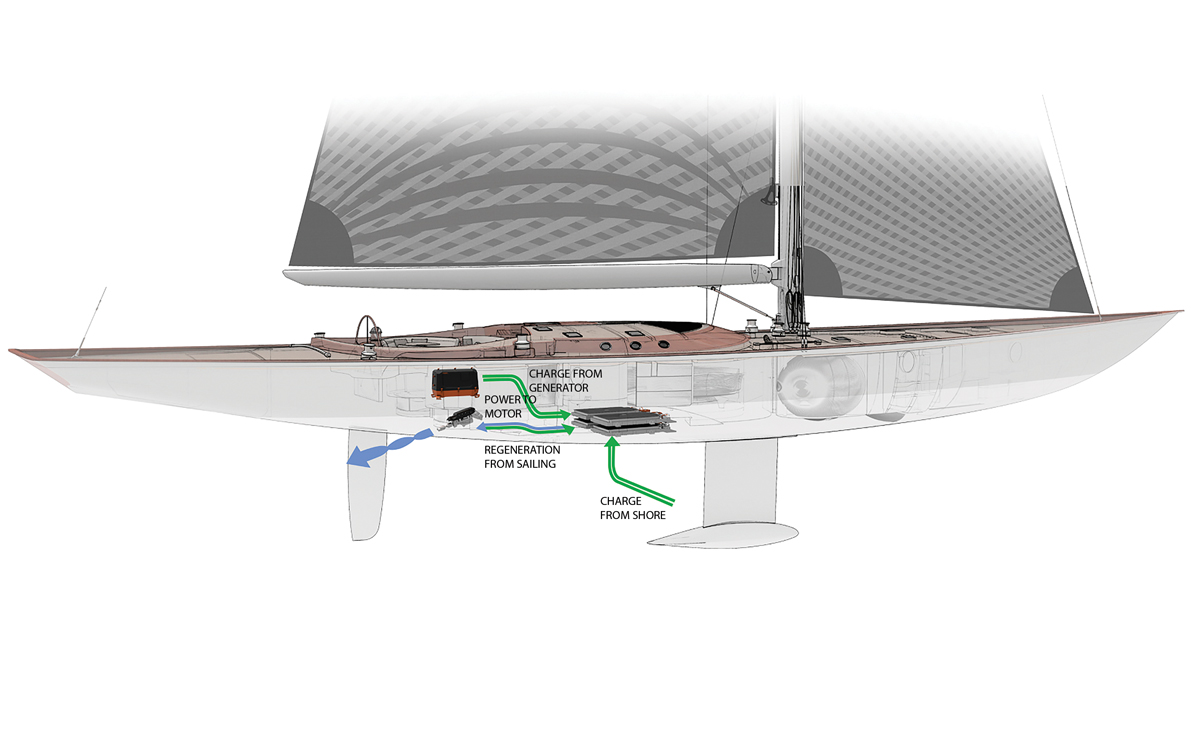
Fully integrated electric drive system will power the new 111ft Spirit Yachts flagship
What does that really mean? Well, in the first instance, it means system integration. If that doesn’t sound revolutionary, then imagine a set-up on board where solar panels, hydrogenerators, batteries, generators and motors all worked seamlessly together to keep the yacht supplied with ample power around the clock. “That’s what people are willing to pay for: plenty of energy with heating or air-con through the night,” says Ballin.
The future of hybrid sailing
In the near future, Torqeedo is planning a new range-extending DC generator specifically for hybrid sailing boats. Its existing unit is built by WhisperPower and provides 25kW, which is too much power for boats using the pod drive system.
The genset will be designed to operate at optimum revolutions, while clever DC to DC conversion decouples the battery voltage from the charging voltage, for much greater efficiency.
With boats, just as with cars, the breakthrough that will make all the difference is around battery capacity. Until range under electric power can match that of diesel, there will be many sceptics. And that isn’t likely to happen for a decade or more, according to Ballin.
“Theoretically, they’ve tested batteries in labs that are ten times more efficient than lithium,” he explains. “And if that comes through, then gasoline is done. But we are trying to combine long-term vision with short-term mindset.”
In the meantime, the prevalent technology is based on lithium-manganese-cobalt, and a process of steady development is making this 5-8% better each year. For example, BMW has just announced its next generation i3 battery, used by Torqeedo’s Deep Blue system, will be able to hold 40kWh of power – an increase of 33% for the same size, weight and nearly the same cost.

Torqeedo Cruise 2.0 FP Pod Drive is suitable for small yachts up to 4 tonnes – a folding prop can also be fitted
The other area of development is around the propeller. Most cruising systems use a folding or feathering prop designed for diesel engines. But Torqeedo’s own research shows that the consistently high torque of an electric motor is best utilised by props with variable pitch.
And yet it is Oceanvolt that has addressed this issue specifically for electric motors with its Servo Prop system, which it claims to be 30% more efficient ahead, 100% better astern and 300% more efficient in regeneration mode.
Oceanvolt says that this prop can pump around 500W into the batteries at just 5 knots – the average pace of a 30ft monohull. At 6 knots that rises to around 800W, and at a very manageable 7 knots for a larger ocean cruiser you get 1.2kW.
“A new technology can rarely compete in price with an established one in its initial growth phase,” says Mustelin. “However, we have passed this and today electric systems are offered at a quite competitive price. When you add to that the fact the electric system is almost service free, the total cost of ownership is turning in favour of electric.”
So, you may not hear them approach, but expect to see more and more electric-powered boats on the water as the revolution continues.
A question of torque
A key part of the viability of electric propulsion rests on the notion that a smaller motor can achieve the same work as a bigger diesel. There are two elements to this. First, a diesel engine is not an efficient converter of chemical energy into thrust, creating a lot of heat and noise in the process. Second, the torque characteristics of electric are much better than diesel.
Mustelin says that Oceanvolt’s 10kW motor “easily outperforms” a 30hp diesel. “Typically, maximum boat speed will be somewhat lower (0.5kt-1.0kt) than with a comparable diesel engine, but at the same time the boat will maintain the speed better in heavy seas and headwind due to higher torque. Manoeuvrability is much better in confined marina spaces.”
That’s because combustion engines only reach peak power (and maximum torque) over a small range of speeds. Torque is a measure of turning power – at the propeller in the case of a boat.
A diesel engine develops optimum torque between 1,800-2,000rpm, while electric motors deliver it from 0 to around 2,000rpm. This allows electric motors to use higher efficiency propellers that are slimmer and more steeply pitched.

Engine-driven: The ‘alternator on steroids’
It has taken years of development and over $10m of funding, but renowned boat systems expert Nigel Calder has helped design an alternator so powerful that it eliminates the need for a generator on board.
Mounted on the engine, on the second alternator position, the Integrel can produce five to ten times more power. Sitting behind the system is at least 10kWh of lead acid batteries (lithium is also an option), and Victron chargers and inverters.
“If you crank the engine it’ll charge the batteries; if you’re running with the engine in neutral, it’ll know it’s in standalone generator mode and switch to that algorithm,” explains Calder. “It will likely be cheaper than a generator installation, and eliminates the issue of the through-hulls, the cooling circuits, the long running hours, the maintenance.”
The system allows you to run all sorts of creature comforts on board that would normally require a generator: from hot water on-demand to coffee makers and freezers. “We honestly believe that this system is going to supplant generators on almost all boats that currently have, or would like to have, a generator,” adds Calder.
With the engine in gear and at low revs, tests show how the Integrel can produce some 2kW of power without increasing fuel consumption or reducing speed – simply utilising the engine’s wasted capacity. This means it will work with the yacht’s existing engine – no need to overspec – and it has already been successfully installed on a new Southerly 480, a Malo 46 and a similar-sized Hallberg-Rassy.

Case study: Dufour 382 Alcyone
Built by Dufour in 2016, Alcyone was immediately retrofitted professionally with Oceanvolt’s SD15 saildrive motor, supplied by a 14kWh lithium battery bank. Owners Michael Melling and Diana Kolpak also specced an 8kWh DC generator for range extension. The fit out cost €30,600 for the motor and battery system, plus an additional €13,744 for the generator, and installation costs were around €8,000.
They charter the boat out near Vancouver, for exploring Desolation Sound and the surrounding area where silent, clean propulsion is a selling point. “Nothing spoils the joy of sailing – or a secluded anchorage – more than the noise and smell of diesel engines,” they explained. “Installing an Oceanvolt system in our new boat has freed us from that. It’s the way of the future.”
Charter manager Merion Martin said the conversion has also been popular with charter customers, adding: “The main advantage of the system is that it consistently uses around 40% less fuel than a standard diesel engine over the course of a week’s charter. But understanding the power management system takes a bit of getting used to, and the many components involved in the system can make troubleshooting a challenge.”
If you enjoyed this….
Yachting World is the foremost international magazine for bluewater cruisers and offshore sailors. Every month we have practical features to help you plan and prepare to realise your sailing dreams. Build your knowledge month by month with a subscription delivered to your door – and at a discount to the cover price. S ee our latest offers now.

FULL-RANGE HYBRID SYSTEMS FOR YACHTS
Protect what you love
SUPPORTED BY ALESSIA ZECCHINI
World Record Freediver
THE FUTURE IS ELECTRIC
E-motion is the only supplier of standardized hybrid propulsion systems that fit into the existing engine room of all serial production yachts from 40-250 feet..

Innovation Award Winner
We are the proud winner of the nmma innovation awards designated by discover boating® miami international boat show®, nmma and bwi., come visit our booth.
and check out how you can electrify your vessel!

MARCH 21-24

OCT 30-NOV 3
Advantages of our hybrid propulsion for yachts.
Significant savings on fuel consumption
Drastically reduce main engine and variable speed generators running hours
Savings on scheduled maintenance
Our hybrid yacht propulsion system is maintenance free. Only the dedicated water cooling pumps require service
Higher resale value of your vessel

Improved Quality of Life on Board

Reduce environmental exhaust and water pollution
Drastically reduce your vessels yearly CO2 emissions
Mooring and swimming in a bay without any gas emissions and noise
Silent and zero-emission departure from mooring and cruise in medium-range
Cabins are noise-free in Zero-Emission or Diesel-Electric Mode navigation
Fishing and trolling in Zero-Emission Mode

HYBRID YACHTS POWERED BY E-MOTION
The e-motion hybrid propulsion systems for yachts are supported worldwide for sales and after-sales services by:.

EXPLORE OUR PRESS PAGE
Stay up to date on all the latest news and events in the rapidly evolving world of hybrid and full electric yacht propulsion. as seen in:, boat , international.
XQUISITE YACHTS - e-MOTION PARALLEL HYBRID- THE 60 SOLAR POWER

The e-Motion Parallel Hybrid - Full-Electric Navigation, Winner NMMA Award 2022

Gale Force Twins used the demo and found out how to troll in Zero-Electric- at the push of a button.

Parallel vs. Serial Hybrid for Yachts - What's the Difference?

e-Motion Hybrid Q&A

Wall Street - Interview Michele Maggi

HYBRID TYPES
The advantages, hybrid functionalities.

The world is going electric.
Interested in the electrification of your yacht download our brochure and get in touch today , “while there have been serial and parallel hybrid systems in boats for years, i have not seen any manufacturer implement a large system with such graceful integration and ease of use for the end-user.”, gary reich - judge of miami 2022 nmma awards.
We think you are located in <strong>Europe</strong><br>To ensure you are seeing career content relevant to your location, please select your correct region using menu on the right
United States & Canada
Eastern Europe & CIS
Turkey, Africa & Middle East
Latin & South America
South East Asia & India
North East Asia
Greater China
FIND YOUR HYBRID SOLUTION THAT MEETS YOUR INDIVIDUAL NEEDS
Hybrid systems for yachts, take your leisure to the next level with quiet, clean and intelligent solutions..
Make the most of your yachting experience with an mtu Hybrid PropulsionPack. Not only does hybrid power reduce on-board noise levels, emissions and vibrations, it also improves efficiency, dynamics and comfort. The components for onboard power and propulsion are modular and scalable. Each hybrid system can be individually designed to meet your requirements.
Enjoy the benefits of silent but highly efficient electric propulsion, exhaust emission-free anchoring – no smell, no smoke, no noise –, emission-free maneuvering in harbor areas, and an all-round environmentally friendly system.
Great maneuverability, E-power assisted propulsion
Comfortable
Silent, vibration-free operation
Meeting the newest emission regulations
Optimized maintenance and operation costs
Discover the mtu Hybrid PropulsionPack
SERIES 2000
Power Distribution Unit
mtu engine series 2000
Electric Machine
Batterie Pack (Air cooled)
SERIES 4000
mtu engines series 4000
Combining full performance with eco-friendly sustainability: Hybrid propulsion opens up a new generation of yachting experience
Discover the future for yacht propulsion in our use case - as flexible and sustainable as never before, with the same power
Use case Yacht hybrid propulsion
Hybrid solutions are among the keystones of a sustainable future. The power of a diesel engine, which allows top speeds, is combined with the sustainable, emission-and vibration-free comfort of an electric drive. The highlight, in addition to fuel and cost savings, is that with a hybrid system, yacht owners can explore waters previously off-limits to diesel drives with a clear conscience. The following use case shows you what such a journey might look like. Learn more in the use case about:
- How comfort and sustainability are strengthened by a hybrid system
- What flexibility hybrid systems allow on board
- How hybrid propulsion systems enable journeys into unique waters
Premium Yacht Service
Latest mtu Yacht Stories
From bridge to propeller from a single source
With Rolls-Royce now a single-source provider of all systems needed to power a yacht, maximum efficiency is assured.
by Lucie Maluck
London to Monaco to save the seas
The 8-strong pedaling team mtu Power4Seas is cycling all the way from London to Monaco to raise funds for the environmental organization Blue Marine Foundation.
by Wolfgang Boller
Green methanol for mtu marine engines
Heading for the future with e-methanol: Rolls-Royce develops high-speed mtu methanol engines as a game-changer for climate-friendly shipping.
by Peter Thomas
Speed, comfort, efficiency, locally emission-free - mtu Hybrid PropulsionPack
Rolls-Royce's mtu Hybrid PropulsionPack offers more than one way to design hybrid propulsion for ships. Adapted to the customer's wishes, it can not only ensure lower emission levels, but also silence on board - whether in the harbor or at anchor.
by Vanessa Bösch
Solution Guide
Marine & Offshore
Download (PDF 14 MB)
Yacht Brochure
Outstanding performance. Unique comfort. Inspiring experiences
Download (PDF 11 MB)
Related Content
Ship Automation Systems
Controlling power with intelligent electronics. As a systems supplier, we not only provide you with the perfect propulsion system, but also with automation systems that are adjustable to fit your needs.
Premium power deserves premium service. You should be able to cruise confidently, enjoying every moment along the way. That confidence starts with reliable mtu engines and continues with Premium Yacht Service.
mtu NautIQ Bridge
mtu NautIQ Bridge is a fully integrated bridge solution. This outstanding ensemble raises overall ship performance, improves safety and offers a new level of customer experience.
Connect with Us
Customer Assistance Center
We are here to take your Sales & Service questions around the clock, 365 days a year.
Sales & Service Locator
Find your local partner for Sales & Service.
mtu Stories
Reports and interviews about mtu products and solutions.
Upgrade your browser for full experience
It looks like you may be using a web browser version that we don’t support. Make sure you’re using the most recent version of your browser, or try using one of these supported browsers, to get the full mtu Solutions experience.
Mozilla Firefox
Google chrome, microsoft edge.
Don’t have permissions to change browser? Contact us and tell us what you’re looking for.

Powering Possibilities Worldwide
Build or refit yachts with reliable global shore power, the perfect fit, ✔ drop-in replacement for charles iso-boost, ✔ identical mounting & wiring, ✔ 3 boosting levels utilizing smart tap system, shore power solutions.

Shore Power Converters

Dock Boost Transformers
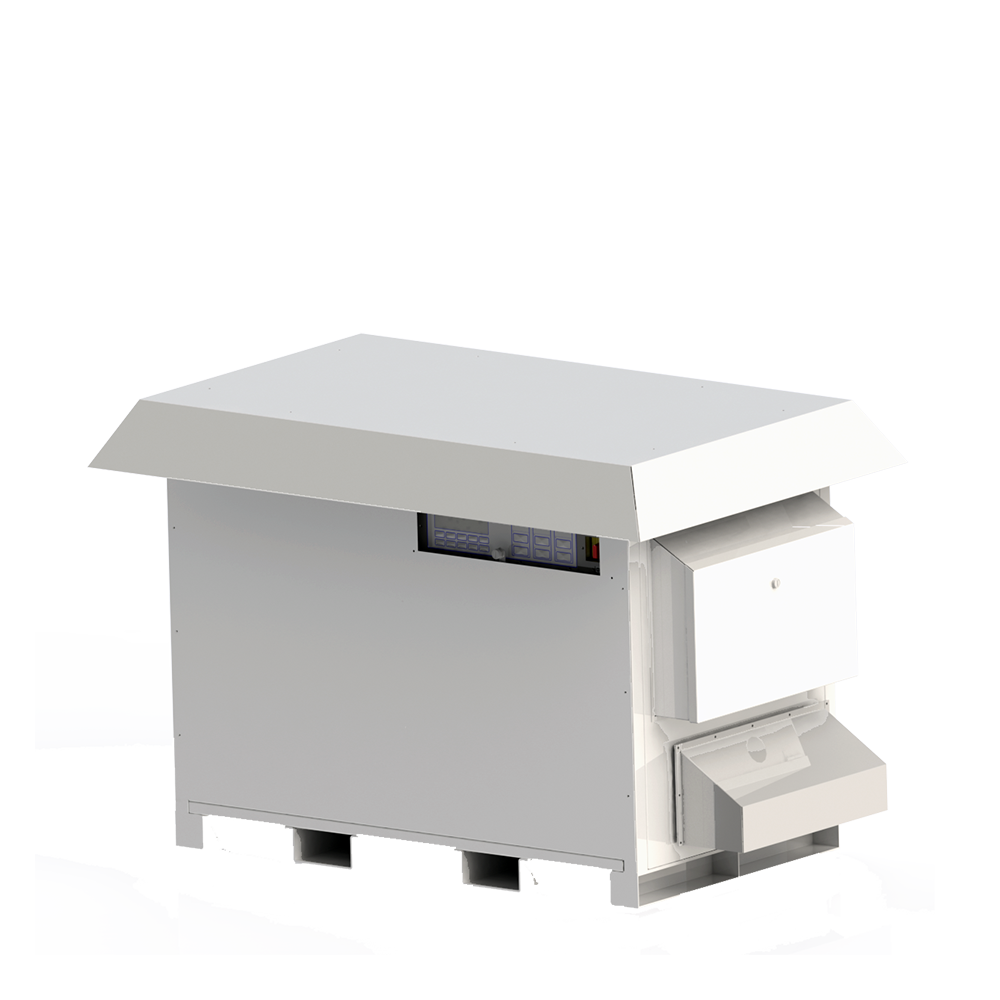
Dock Locker Systems
Global support network.
Our global support network covers 127 countries and counting. ASEA Power’s broad network of trusted service providers is strategically located in main ports across the globe to provide the support you need when you need it.
SAFETY FIRST
Every ASEA shore power converter is equipped with an Isolation transformer for a crucial reason: safety. By isolating the ship’s power system from the shore power, the risk of fault current fl owing through the water and endangering swimmers is eliminated.
RELIABILITY
Reliability is at the heart of ASEA Power Systems. We pride ourselves on delivering unparalleled reliability, ensuring that our customers have a seamless and secure connection to shore power no matter where their journey takes them. Our products are trusted by yacht owners, marinas, and shipyards worldwide.
Customer Service
Ratings and reviews.
ASEA Power Systems is committed to providing world-class support for our customers.
- Customer Satisfaction 97% 97%
“We are extremely pleased with our experience at ASEA, from start to finish. Tech support was on point: Jason Woodward went above and beyond the call of duty to service our needs. We can’t speak highly enough about our experience with ASEA. Their equipment speaks for itself, and their service matches the quality of the hardware. 10/10!”
“Once again Lizette and Gabriel went above and beyond to make sure the problem was identified and replacement parts were ordered and shipped on time. Thank you for all the help, great job!”
- Weekly Newsletter
California's Boating & Fishing News

Hunter 33 sailboat anchored in Avalon, Catalina Island Walt White image.
Advantages of Choosing 48V DC Systems for Electric Yachts
NEWPORT BEACH— As the global focus turns to cleaner, greener energy sources, converting yachts from internal combustion engines (ICE) to electric propulsion has become increasingly popular. Among the voltage options available, 48V DC systems offer numerous advantages, including safety, availability, and cost-effectiveness. In this article, we will explore the benefits of opting for a 48V DC system when transitioning a yacht from diesel or gas to electric propulsion.
Electric propulsion is particularly well-suited for sailboats, as the vessel’s sails provide an additional source of power, supplementing or even serving as the primary means of propulsion. The electric motor can act as a secondary power source, making it an ideal fit for sailing enthusiasts who prioritize efficiency and environmentally friendly options. The complementary nature of sail and electric power allows sailors to optimize their energy consumption while maintaining an eco-conscious approach to boating.
Creating an Optimal Electric Propulsion Experience:
Making a great user experience with electric propulsion involves several key factors :
- Smooth and quiet operation
- Ease of use
- Reliable performance
- Efficient energy management
- Easy maintenance
- Clear monitoring and display
- Quick and efficient charging
- Safety features
- Safety and Regulatory Advantages of 48V DC Systems
Electrical Safety on Boats:
Compliance with marine electrical standards, such as those set by the American Boat and Yacht Council (ABYC), is crucial for safety. Systems using voltages higher than 48V DC often involve additional safety and regulatory requirements. By selecting a 48V DC system, the voltage stays below the 60V DC limit, bypassing these extra regulations and ensuring a “touch-safe” environment on board.
Compatibility with Electrical Equipment:
First let’s look at a list of typical “house loads” on a yacht (these are all the electrical loads on board, except for the electric motor used for propulsion).
Grouped into AC and DC loads, with approximate power consumption for each:
- Interior and exterior lighting (LED) – 1-3W per light
- Navigation equipment (chartplotter, GPS, radar, etc.) – 10-50W
- Communication equipment (VHF radio, AIS, satellite phone, etc.) – 5-25W
- Starlink Satellite Internet Service – 75W
- Water pumps (freshwater, bilge, shower sump, etc.) – 10-50W
- Refrigeration and freezer units – 40-200W
- Marine electronics and instruments (depth sounder, wind instruments, autopilot, etc.) – 5-50W
- Battery charging systems (for main and auxiliary batteries) – 10-50A
- Electric toilets and holding tank pumps – 10-50W
- Anchor windlass – 500-2000W
- Bow and/or stern thrusters – 2-8kW
- Electric winches and sail handling equipment – 100-800W
- Ventilation fans and blowers – 10-50W
- Security and monitoring systems (alarms, cameras, etc.) – 5-20W
- Entertainment systems (TV, stereo, speakers, etc.) – 50-300W
- Galley appliances (microwave, stove, oven, etc.) – 500-1800W
- Air conditioning and heating systems – 500W-10kW
- Inverter and/or generator for AC power supply – 50-2000W (depending on the size of the inverter/generator)
- Shore power connections and charging systems – 500-2000W
- Electric dinghy davit or crane system – 500-2000W
- Water-makers and water purification systems – 300-2000W
One significant advantage of a 48V DC system is the broad range of compatible electrical equipment available for yacht re-powering. Retrofitting or replacing house loads with a 48V DC system is generally a straightforward task for marine electrical technicians, and often even for boat owners, as it avoids the complexities associated with high-voltage systems.
Inboard motors for propulsion, like the Newport-25, operate on 48V DC power, eliminating the need for any high-voltage systems on board. Other essential components such as power inverters, battery chargers, and solar chargers are also more readily available and affordable for 48V DC systems compared to higher voltage alternatives.
Simplified and Cost-Effective Power Conversion:
Converting power from the main battery to support various onboard loads is a crucial aspect of re-powering a yacht with an electric propulsion system. With a 48V DC system, it is simpler and more cost-effective to convert power to the commonly used 12V DC for house loads, such as pumps, lights, cockpit instruments, and radios. This conversion can be easily achieved using a DC-DC converter that steps down the voltage from 48V to 12V DC. With the exception of the windlass and bow thrusters, high-power 12V DC systems can be easily accommodated with this setup.
In Summary:
Choosing a 48V DC system for re-powering a yacht from diesel or gas to electric propulsion offers numerous benefits, such as enhanced safety, compatibility with a wide range of equipment, and cost-effective power conversion. By staying within the “touch-safe” range and avoiding additional regulatory requirements, yacht owners can experience a seamless transition to cleaner and more sustainable electric propulsion without compromising on performance or convenience.
Sailboats are well suited for electric propulsion. They typically have lower power and speed requirements than power yachts, which makes them a fitting choice. The lower power demands mean that they can operate with smaller battery banks and motors, reducing both the weight and cost of the overall system. As a result, sailboats can enjoy the advantages of electric propulsion, such as reduced noise, minimal vibrations, and easier maintenance, without the need for large, expensive power systems. The combination of sails and electric propulsion provides a sustainable and enjoyable boating experience that emphasizes the importance of harmony with nature while meeting the needs of today’s eco-conscious sailors.
About the Author:
Walt White is the founder and CEO of NewportElectricBoats.com and Systems engineer, working to bring products to market that are best in class and make a positive impact on the environment. Our electric motors and monitoring electronics help sailboats transition to battery powered electric propulsion. Newport Electric Boats designs electric propulsion systems for sailboats.
Caption: Hunter 33 sailboat anchored in Avalon, Catalina Island
Walt White image.
This article was reprinted with permission from the author, Walt White, CEO of Newport Electric Boats and was edited for formatting by the Log. The article can also be found at newportelectricboats.com .
- ← Fast Facts: Chain of Command— The Bosun and Their Role
- Ask A Maritime Attorney: Can you explain the property tax allocation after purchasing a used boat? →
Comments Cancel reply
Your email address will not be published. Required fields are marked *
Your Thoughts are Appreciated
Save my name, email, and website in this browser for the next time I comment.

What Is Shore Power?
From those new to the yacht world, we’re often asked exactly what is shore power. It’s precisely what is sounds like – it’s how you power a ship when it’s at shore. It’s what lets you turn on the lights, maintain a comfortable climate, run your laundry – any of those things you do aboard your vessel.
At sea, ships run on diesel fuel. While the sights and sounds of burning diesel aren’t the most pleasant – think exhaust, the rumbling engines, etc. – that’s not a big deal when you’re surrounded by water.
At shore, ships can also run on diesel – but what if we told you there’s a better way?

Clean Marine Shore Power
Let’s face it – nobody really likes diesel. It’s loud, it contaminates both air and water, and all those hours burning diesel fuel at shore really add up, both in operating costs and engine maintenance. And if that’s not enough, changing tax regulations in recent years are making it even more costly to run a yacht on diesel when docked at shore.
What’s the solution? It’s using electricity for your shore power. When running off electricity, your diesel engines shut down, you cut your pollution output, you cut the excessive noise of idling your engine, and you drastically cut your fuel bill.
How Can I Use Shore Power?
Now that you know what shore power is, you’d think using it would be as easy as just plugging in. But as any world-traveling yacht captain knows, you don’t just dock and plug in. Ports around the world operate at different electrical voltages, which usually won’t match the voltage your ship operates on. It’s essential that those voltages match if you want to power your ship with electricity.
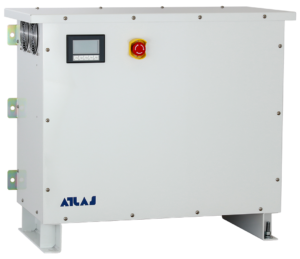
The key to using electric shore power on an international-faring yacht is an electrical frequency converter, like those pictured above. These systems, once installed on your craft, help convert the port’s electricity to work with your onboard system’s setup. This gives you reliable electric power for all your ship’s functions throughout your stay.
Marine Shore Power For Yachts Of All Sizes
Atlas Marine knows yachts come in all shapes and sizes, and we provide frequency converters to fit them all. Our converters are based on KVA ratings and range from single power modules of 37.5 kVA to 200KVA, with ability to parallel systems and get all the way up to 1MVA.

Upgrade Your Yacht’s Power Today
With decades of powering the world’s greatest yachts, Atlas Marine Systems has a variety of frequency converters to help you run cleaner, quieter, and more reliably, wherever your travels take you. We also provide electrical design services for those looking to maximize their vessel’s power distribution system. Contact Atlas today to get started in the world of clean, reliable shore power.
Field test: PV Modules
A real world comparison between Mono, Poly, PERC and Dual PV Modules.
* This is a field test and the results are specific for this installation on this location please research which is the best solution for your own situation as the results can be different based on environmental influences.
Total solar yield as of 27/03/2023 when the results were reset: Mono: 9158 kWh Split-cell: 9511 kWh Poly: 9113 kWh Perc: 9471 kWh Perc-east: 1970 kWh Perc-west: 1730 kWh
Enjoy the sound of silence
Harnessing the power of the wind makes sailing an unforgettable experience. All you want to hear is the sound of the wind blowing and the waves breaking. But what is the best way to power the on-board electronics while the engine and generator are switched off? Victron combines energy storage and solar generation to provide the power you need. In absolute silence.
Whether you’re sailing away for the weekend or planning a trip around the world, big chance the very same Victron solution could support both. It’s the level of comfort that really determines your optimal solution aboard. With Victron you can power just about any plans, but as an example we illustrated ‘normal’ and ‘heavier’ power profiles in the below for the ‘average’ sailing yacht.
Consumption
- Power Profile
- Complete system
How much do you need?
A modern sailing yacht is packed with a lot of electrical equipment. Most things used to run the boat usually use DC, bigger (household) appliances need AC. When it comes to estimating power consumption, many just add up the Watts. Time is equally important. A microwave might use 1000 Watts, but only for 2 minutes. A fridge might consume as little as 50 Watts, but is turned on 24 hours a day.
For inspirational purposes we’ve outlined 2 system examples based on ‘normal’ and ‘heavier’ use.
1.2 - 2.4 kWh / day
'normal' and 'heavier' energy consumption. Read more
The microwave uses 1000W an hour but is only on for 2 minutes a day. 1000W / 60 x 2 = 0.03 kWh / 2 minutes
The fridge uses 50W an hour but is on the entire day (actually cooling ½ the day). 50W x 24hrs/2 = 0.6 kWh / day
Storage & conversion
How much energy should be stored.
Storing energy allows you to live of shorepower at sea or lets you use solar power harvested during the day over night. The inverter will convert the stored power to 230V. Sailing yachts typically experience long intervals between battery recharges, so your house battery should have a generous capacity. As a rule of thumb, we’re calculating with 48 hrs on board without shore power shore/engine/generator/solar power. Multiply the daily power consumption x days for even greater independency.
The storage capacity of a lithium battery should be two times the daily power consumption.
Due to its ±50% smaller discharge capacity, the storage capacity of a lead-acid battery should be four times the daily power consumption.
The inverter should be sized to handle the average load continuously and should match the expected peak power current, which our inverters handle very well (on average 2 x their continuous current).
Where does the power come from?
Sources of power, power profile.
Normal and heavier power profiles in kWh, based on the daily energy consumption, which should be in balance with the generation.
Storage batteries in Ah, double the capacity using lead-acid batteries.
It seems like your browser does not support the latest technologies. To see this section properly, consider using a modern browser.
System diagram
For a lithium and lead-acid battery based system.
How do the system design considerations translate into a robust system?
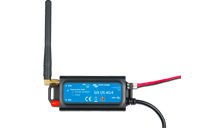
GX 4G modules

The professionals choice:

You’ll want to bring small devices on board for your trip. Or use household appliances like a microwave. These usually run of an AC outlet. Think of:
- Phone charger
- Refrigerator
Being able to plug-in these device saves you the trouble of finding a DC version.

Boat engines
Sailing yachts have one or two diesel engines (Catamarans) to get from harbour to horizon. The engines come with alternators to charge the engine batteries, drive fuel pumps, etc.
Once the starter batteries are recharged, the engines can also power the boat electrics and recharge the house battery. On bigger yachts you’ll find power hungry DC equipment such as anchor windlasses and bow thrusters. The engines have to be running before you can use them.
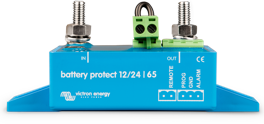
BatteryProtect
Discharging your battery too far will damage it. Adding a Victron BatteryProtect will disconnect the boat’s electronics when the battery voltage drops below a pre-set level. It will also automatically reconnect everything when the battery is sufficiently recharged.
There is more to a Victron BatteryProtect. The built-in shutdown delay ensures that vital electronics aren’t disconnected in error, i.e. when starting the engine causes a short drop in battery voltage.
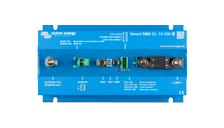
Battery Management Systems
Battery management systems take excellent care of Lithium batteries, protecting the individual cells of LiFePO4 batteries against over voltage, under voltage and over temperature and will shut down or reduce charging (VE.Bus products only) or disconnect the loads when this occurs.
Victron Energy offers several BMS options, in general the VE.Bus BMS and smallBMS signal separate devices to disconnect the charging (Inverter/Chargers, Cyrix-Li, DC-DC chargers) or disconnect the loads (BatteryProtect, Inverter/Charger), the modular Lynx distribution system features the Lynx BMS and other modules for more control over the DC busbar. For vehicles and boats all-in-one functionalities are available in the Smart BMS versions for Victron Lithium batteries, but also include current limiting to protect the alternator from overheating and BatteryProtect-like functionality to shut down the loads when pre-set critical battery conditions are met.
Victron Energy also offers full flexibility when it comes to selecting a third-party off-grid battery bank (and their BMS) of choice. A large number of well supported Lithium battery manufacturers can be easily integrated through the use of a mandatory GX-device. This flexibility enables our customers to perfectly match their off-grid needs for their unique power situation. When working with unsupported brands, a Victron Energy Battery Monitor is required to pass on accurate state of charge readings to the wider system.
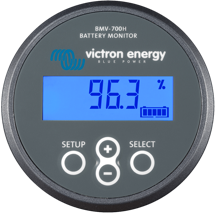
Battery Monitors
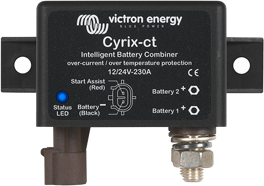
BatteryCombiner
The Cyrix BatteryCombiner is the only safe way to connect the house battery to the starter battery (to start your boat’s engines). With a BatteryCombiner you can charge the house battery from the alternator without running the risk of draining the starter battery (which always should be ready to go). When other sources of power are available (eg. shore/solar/generator power), the Cyrix BatteryCombiner will allow bi-directional charging from the house battery to the starter battery.
When the Voltages of the starter and house batteries are the same, use a Cyrix: its current rating should be equal or bigger than the current rating of the alternator. If the house battery is Lithium and the alternators Amperage is smaller than the house battery, or when the Voltages of the starter and house battery are different: use a Orion or Buck-Boost.

Boat Network
Keeping grips on all the systems on board can be a hassle. The solution: tie everything together in a single boat network using NMEA communication standards. Your boat network can include navigation equipment, tank senders, battery monitoring and much more. The status information can trigger alarms and shutdowns, adding to the safety on board. The Cerbo GX now supports the NMEA2000 out protocol, allowing you to monitor your boat’s network of systems from wherever you are.
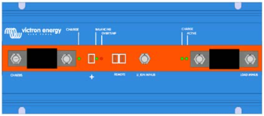
The BMS 12/200 is a dedicated battery management system (BMS) that protects Victron Smart 12,8V LFP batteries against deep discharges, overcharging and high temperatures with up to 200 Amps maximum DC current. When critical values are exceeded, the BMS acts immediately: loads are disconnected physically in case of a deep discharge and charging is stopped when there is a risk of overcharging. High temperatures trigger an immediate end to both charging and discharging.
This is the only BMS that can be directly connected to an alternator, protecting them from overload/overheating. This works with a combination of an AB fuse (rated in accordance with the expected max load current of the alternator) and an internal programmable input (which limits the input current electronically to 80% of the AB fuse).
Please check your manufacturer for the maximum charging current of your alternator and size AB fuses of the BMS 12/200 accordingly, see manual.
When different Lithium batteries & higher voltages are used, other solutions are needed, such as the VE.bus BMS and Lynx Ion BMS.

Boat Electronics
A sailing yacht is home to several electronic devices. These are all connected to the house battery. Think of:
- Boat control panel
- Log/depth sounder
- Chart-plotter or GPS
- Navigation lights
- Bow thruster
- Interior lighting
- Music player
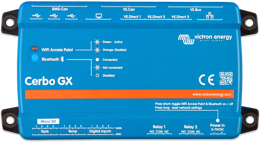
The Victron Cerbo GX is the communication-centre of your boat’s installation, allowing you to always have perfect control from wherever you are and maximises its performance. Simply connect through our Victron Remote Management (VRM) portal, or access directly, using the optional GX Touch 50 screen, a Multi Functional Display or our VictronConnect app thanks to its added Bluetooth capability.
The Victron Cerbo GX is an easy to use visual system. Instantly monitor the battery state of charge, power consumption, power harvest from PV, generator, and mains, or check tank levels and temperature measurements. Easily control the shore power input current limit, (auto)start/stop generator(s) or even set quiet periods to avoid starting the generator in the middle of the night. Change any setting to optimise the system, follow up on alerts, perform diagnostic checks and resolve challenges remotely. The Cerbo GX turns any power challenge into an effortless experience.
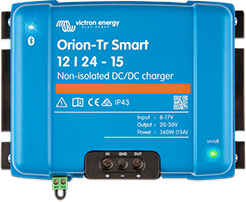
DC-DC chargers
DC-DC converters, or battery-to-battery chargers (converters with built-in charge algorithms) are used in dual battery systems, where the (smart) alternator and the start battery are combined with the service battery (of equal or different voltages) to charge it. They can also be used to charge applications that have dedicated batteries (eg. bow thrusters), or to power applications that have a voltage different than the service battery bank.
Most DC-DC chargers can be used in 12V or 24V systems and all are suitable for both lead acid and lithium batteries. Some DC-DC charger models can be parallel connected to increase the output current. DC-DC chargers are a perfect and safe solution to charge Lithium battery banks from smart alternators (and lead-acid batteries for that matter).
Charging lithium batteries from the alternator Most alternators cannot be directly connected to lithium batteries. A lithium battery will draw more current than the alternator can supply, which may result in permanent alternator damage. To not damage the alternator, current limiting is one of the options to stay within the safe zone of the alternator.
Victron offers multiple solutions to solve this problem, of which one of them are the DC-DC converters:
- DC-DC converters act as a current limiter between the alternator and the battery: the battery can be safely charged without blowing up the alternator.
- Victron also offers alternative solutions for dual battery systems powered by alternators. Some (smart) BMS products physically limit the current drawn from the alternator, in other systems, battery combiners might be a solid option. See the datasheets for more info.
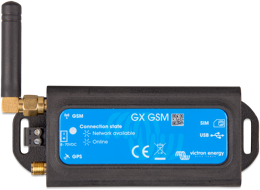
GX GSM Dongle
The Victron GX GSM is a 3G cellular modem that enables GX devices with mobile internet for the system and connection to the VRM Portal, allowing you to monitor your system from remote. When the boat is in range of a 3G network, it will send data to the VRM website and you can monitor the boat from your smartphone. The GSM module adds tracking the boat, recording your trips and putting up a geo-fence around the boat. You will get an alert via mail when the boat travels outside the geo-fence area.
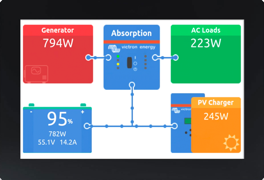
The Victron Energy Cerbo GX is the communication-centre of your systems installation, allowing you to always have perfect control from wherever you are and maximises its performance. The optional GX Touch 50 is a companion to the Cerbo GX, it’s five inch touch screen display gives an instant overview of your system and allows you to adjust settings in the blink of an eye.
Instantly monitor the battery state of charge, power consumption, power harvest from PV, generator, and mains, or check tank levels and temperature measurements. Easily control the shore power input current limit, (auto)start/stop generator(s) or even set quiet periods to avoid starting the generator in the middle of the night. Change any setting to optimise the system, follow up on alerts, perform diagnostic checks and resolve challenges remotely with the free Victron Remote Management (VRM) portal.
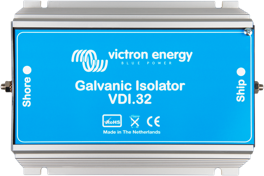
Galvanic Isolator
A galvanic isolator prevents electrolytic corrosion. The isolator is mounted directly behind the shore power connector on board. It blocks DC currents that might leak through the shore power earth terminal. These currents can cause corrosion to all metal parts under water, like the hull, propeller, shaft, etc. The galvanic isolator should have the same power rating as the incoming shore power.
It’s a misunderstanding that galvanic corrosion occurs only in metal and aluminium hulls. In fact it can occur on any boat as soon as a metallic part (the shaft and propeller) is in contact with water. Galvanic corrosion will quickly dissolve your sacrificial anodes, and attack the shaft, propeller and other metal parts in contact with water as soon as the boat is connected to the shore-side supply. It might therefore be tempting not to connect the ground conductor: this is however extremely dangerous because Ground Fault Current Interrupters will not work nor will a fuse blow in case of a short circuit to a metal part on the boat.
The safe option is to use a Galvanic Isolator for non-metal smaller boats, or use an isolation transformer for metal boats or boats with bigger systems.
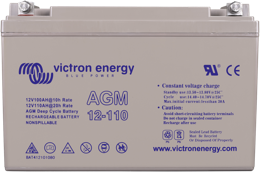
House battery
The house battery stores power for the boat’s electrical system. Sailing yachts typically have long intervals between battery recharges and the house battery should have a generous capacity.
For a house battery you can choose from two types: lead-acid and lithium. There are various reasons to favour one over the other. Here are a few common ones:
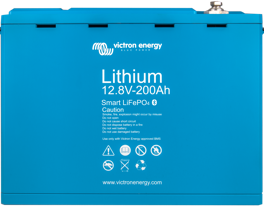
Inverter/Charger
The inverter/charger is the heart of the system. In the marina, it charges the batteries from shore power. While sailing it inverts the energy from the boat’s battery into AC power for household devices. The switch from charging to inverting and from inverting to charging is seamless.
- Victron inverter/chargers come with a handful of outstanding features:
- PowerControl: automatically manage battery charging to prevent an overload of the generator or shore power.
- PowerAssist: uses the battery as a buffer to assist the shore power during peak power demand.
- Perfect power: even sensitive devices run flawlessly on the pure sine wave power.
- High peak-power: use motorised equipment without overheating.
- Low self consumption.
For this power profile we would recommend:
We would recommend our Multiplus-II inverter/charger. If you have a generator on board you’ll need a Quattro inverter/charger, which has an extra input (shore power and generator).
We strongly recommend 24 Volts for new boats. The higher voltage is simply a better choice when it comes to meeting the power demands of a modern sailing yacht. If your boat’s system is based on 12 Volts, select a 12 Volts unit instead.
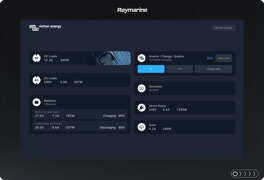
MFD GX Integration
The Victron integration between our GX range and several leading Multi Functional Display manufacturer brands enables you to easily connect an MDF to the heart of your power system such as the Cerbo GX, or the GX enabled Multiplus-II GX. Once connected you can easily monitor and control your boat’s power system, right on your Glass Bridge.
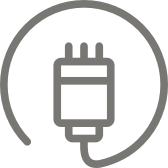
Shore Power
In the marina, the boat will be connected to shore power. Shore power recharges the batteries. It can also be used for maintenance and to run large AC loads.
Often shore power is limited in how much power you can draw, i.e. just 10 Amps. Berths with higher ratings might not always be available. Victron inverter/chargers allow you set a maximum shore power current. Now you can charge your batteries and turn on any equipment without blowing a fuse.
Sometimes shore power is less than perfect. You might run into voltage drops if you’re at the far end of the harbour. There could also be power surges, which could harm sensitive equipment on board. Victron’s inverter/chargers smooth out these problems and turn bad power into perfect power.
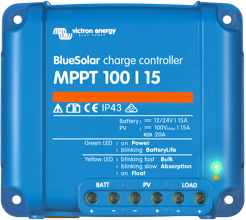
Solar charger
A solar charger- also called MPPT controller, harvests the power from the solar panels to charge the house battery. Solar chargers have the same charging cycles as our regular, fully automatic, battery chargers. When your boat is moored without shore spower, solar power is a great way to keep the batteries charged.
In a marine environment, the performance of solar panels changes constantly. Victron’s solar controllers use ultra fast maximum power point tracking to squeeze up to 30% more power out of your panels.
The rating of the solar charger is defined by the size of the solar panel. For solar panels of less than 150W or less, choose a 75/10 charger. If your solar panel produces between 150 and 220W, pick a 75/15 instead.
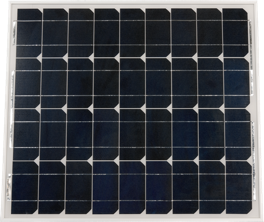
Solar panel
More and more sailing yachts area equipped with solar panels. After all, they extend the autonomy range without the noise of a diesel engine and… for free. Victron offers a wide range of small, highly efficient, solar panels that are just perfect for boats.
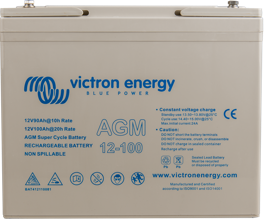
Starter Battery
The starter battery is needed to start your boat’s engine. These batteries are different from house batteries and engineered to deal with a large discharge current. The starter battery should always be ready to go. It’s best to isolate the important starter battery from all other electrical circuits on board, so it cannot be accidentally drained of power.
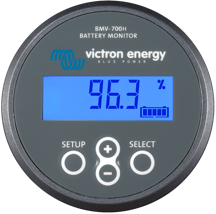
VE.Direct Bluetooth Smart dongle
The Bluetooth dongle enables you to use the VictronConnect app with VE.Direct enabled devices (without Bluetooth built-in). With the app you can have real-time insight and full control, and you can access all VE.Direct enabled devices such as the smaller VE.Direct inverters, the BMV 70x series battery monitors or MPPT solar controllers.
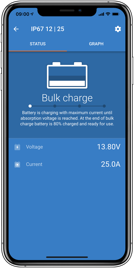
VictronConnect
All Victron products on your boat can be monitored and controlled from the palm of your hand. Just connect the VictronConnect App via Bluetooth and you’ll have direct access to values like battery voltage and current. You can also turn devices on or off, as well as change their settings.

VRM - Victron Remote Management
Monitor and manage.
Monitor and manage your Victron Energy systems from anywhere and catch potential issues early by setting alerts and alarms. With VRM you are always in perfect control from wherever you are.
VRM works with a GX-device such as the Cerbo GX with internet connection, the GlobalLink 520 or GSM LTE 4-g for smaller systems.
Monitor the battery state of charge, power consumption, power harvest from solar, generator and mains in real-time. Optimise the energy harvest and usage with history graphs and detailed analytical reports. Catch potential issues early by setting alerts and follow up on alarms to prevent definitive system failure.
Easily control the shore power input current limit, switch on the inverter, (auto)start/stop generators or even set quiet periods to avoid starting the generator in the middle of the night. With VRM you can change any setting, follow up on alarms, perform diagnostic checks and resolve challenges from wherever you are.
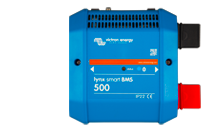
Lynx Smart BMS
The Lynx Smart BMS is a dedicated Battery Management System for Victron Lithium Smart Batteries (for non Victron Lithium batteries, see below). There are multiple BMS-es available for our Smart Lithium series of batteries, and the Lynx Smart is the most feature rich and complete option. Its main features are:
- Built-in 500A contactor, used as a fallback safety mechanism and also suitable as a remote controllable main systems switch.
- Battery monitor, indicating state of charge percentage and more data.
- Pre-alarm signal: provide a warning before the system shuts down due to -for example- a low cell.
- Bluetooth for use with our VictronConnect App, for setup and monitoring.
- Local and remote monitoring using a Victron GX device, for example the Cerbo GX.
Battery Management System
The dedicated battery management system (BMS) protects Victron Lithium Smart batteries against deep discharges, overcharging and high temperatures. When critical values are exceeded, the BMS acts immediately: loads are disconnected physically in case of a deep discharge and charging is stopped when there is a risk of overcharging. High temperatures trigger an immediate end to both charging and discharging.
Battery monitoring
Lynx Distribution system
Non Victron Lithium batteries
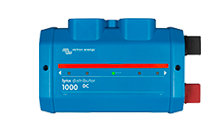
Lynx Distributor
The Lynx Distributor is a modular DC busbar, with locations for four DC fuses. It will monitor the status of each fuse, and indicate its condition with a LED on the front. When connected to a Lynx Smart BMS or Lynx Shunt, the status of the fuses will be visible in VictronConnect and VRM (when the Lynx Smart BMS is connected to a GX-device).
Multiple Lynx Distributors can be used to connect all the DC-loads and charge sources on one side of the BMS, on the other side, a Lynx Power In (without fuses) or another Lynx Distributor (with fuses) can be used to connect the battery bank to the modular busbar.
This product is part of the modular Lynx busbar system that also provides the Lynx Smart BMS, a dedicated Battery Management System for Victron Lithium Smart Batteries (for non Victron Lithium batteries, use the Lynx Shunt).
Power consumption will vary from yacht to yacht and from owner to owner, even on sailing yachts. Here are two examples - with a normal and a heavier daily energy consumption - of what an Optimal Energy plan for a sailing yacht could look like. Please note that many more factors come into play when designing and installing your optimal solution: your Victron Professional will gladly help you with that.
To see this detailed table and the entire section properly, consider using a modern browser.
It seems like your browser does not support the latest technologies to see this section properly, consider using a modern browser.
MultiPlus magic: small generator, big power.
An expert view: lithium or agm aboard, get your wiring right with wiring unlimited, see your system performance right from your glass bridge, see all our marine products and more configurations., real-time insight and complete control with our victronconnect app, find your local dealer.
Our well established global network of local Victron Professionals is dedicated to help find an optimal solution for your challenge.
Count on our worldwide service
At Victron we find it essential that customers are serviced and supported quickly and competently. This is why our global network of Victron Professionals pack the highest level of technical know-how and are committed to deliver repairs as fast as possible.
So you can start or continue your journey, wherever you’re headed.

Do you operate a yacht? Our app is perfect for you
Yacht electrical systems - basic overview & useful resources.
Yacht electrical systems are often overlooked. This can come from intimidation, lack of knowledge, or fear of accidents. For the most part, however, it is the result of lacking the expertise to deal with issues that arise.
Yes, yacht engineers may be the experts when it comes to everything below deck, but not all are qualified to operate as electricians. Due to this, boat owners often outsource such tasks to local contractors.
However, involving third parties is not always necessary. Very often, a basic understanding of the boat’s electrical systems will help you troubleshoot and resolve small issues before they turn into big problems. All you need, in this case, is an organized overview of the things you need to pay attention to. And that’s exactly why we created this post.
The goal of this article is to give you a high-level understanding of your vessel’s electrical systems. This way, you will be able to turn from reactive to proactive, eliminating any and all potential issues that can be prevented.
In the next few chapters, we will discuss four areas you should focus on, and some useful resources to help you learn how to handle them properly. Hence, it might be best for you to bookmark this article for future reference. Let’s delve in!
- Learn how to use the right tools
- Yacht electrical systems - start from the battery
- Dealing with corrosion
- When to call in an expert
- Wrapping up
1.Learn how to use the right tools

An engineer’s ability to discover and resolve electrical issues is directly linked with the tools he uses. There are several tools that are important for this. You will usually find them in the form of a “ basic toolkit ”, which includes things like wire-cutters, a crimper, a multimeter, a wire stripper, among others.
The most important tool among them, and the one you should definitely learn how to use, is the multimeter .
The multimeter is one of the most critical tools to have on your boat to keep yourself self-sufficient for troubleshooting. It is fairly simple in its use, and common among all types of electricians. The following video gives a great overview of the way you should use it on your boat.
2.Yacht electrical systems - Start from the battery
One of the first and most important things you need to learn is the types of batteries on your vessel, and how you should go about maintaining them. Start from this guide to get a better understanding of the different types of batteries and what is required for their maintenance.
To ensure that your batteries and charging station are working as they are supposed to, you need to be aware of their “normal” state. To establish this baseline, start by tracking your battery levels during different parts of the day (morning, mid-day, night), and collect data based on different weather conditions (windy, rainy, sunny). Then also check if the charging stations are operating the way they are supposed to. This way, you will be able to identify when the levels of your battery are out of the norm, which in turn will help you spot what caused the irregularity.
Here are some useful questions to answer when it comes to your battery system:
- What type of batteries does your vessel have and what is their current condition?
- Are the battery connections well-maintained and clean?
- Is the battery system properly enclosed and secured?
- Is it possible that the battery is overcharged or overfilled?
- Does your vessel have a secondary, starter battery?
- If you have a separate starter, can it be paired with your main battery in case of an emergency?
The answers to these questions will help you determine the current condition of your yacht electrical systems, while also save time for contractors that may be called to do some work on board.
Of course, batteries are just a small part of the total. To get a better understanding of the basics of electrical systems on board, it might be a good idea to take a seminar that delves into all the important aspects. We managed to find a great 6-part recorded seminar on Youtube that educates boaters on marine electrical basics. The videos are free to watch and filled with useful tips and information to help you get a better understanding of your vessel’s electrical components. Note that the educational part starts at the second video of the series.
3.Dealing with corrosion
By now you should have gained some basic knowledge of the tools and skills you need to tackle problems related to yacht electrical systems. At this point, you will want to learn how to spot and deal with corrosion issues, in order to save yourself time, money, and unnecessary stress. Thankfully, this can easily be done in a DIY fashion, as you can mostly troubleshoot the issue on your own.
Corrosion is one of your most feared enemies onboard. It is important that you know what to look for and learn to identify situations that can lead to it. A common quote among marine electricians is that, if a marine electrical problem occurs, it is 90% of the time a result of corrosion. Due to this, most electrical issues can be resolved if you simply learn how to spot and deal with corrosion . As mentioned above, it is also a great way to save money and time, as you will cancel out this possibility before calling expensive contractors.

If you have at least some basic experience in yacht electrical systems will most likely be able to spot the cause of a problem if you have an adequate understanding of how to use the multimeter. In many cases, all that needs to be done is clean up the corrosion, put everything back in its place, and check to see if everything works properly.
We recommend reading through this article , to get a better understanding of the issues leading to corrosion and how to deal with them.
4.When to call in an expert
It is important to note that experts in this particular field are either ABYC-certified marine electricians or trained in RCD and ISO standards (Europe). If you can’t find someone with these particular certifications, then at least try to find someone with adequate experience in marine-based electricity systems. Land-based electricians may be experts in their field, but can often cause more problems than repairs when working on your vessel.
Knowing this, there are several occasions on which it is best to call an expert:
- If you do not have the experience and expertise to resolve the issue at hand and are worried that your efforts may worsen the situation.
- If the problem involves shore power and problems with wiring. Unless you are a qualified electrician, it might not be in your best interest to start rewiring the pedestal, transformer, or cables. Make the dockmaster aware of the issue and, if needed, call a yacht electrician.
- In case of evidence pointing to electrical damage onboard. This includes things like burnt wires or melted parts. You can see most of them in the first part of the seminar we linked to in the video above.
- If you notice early indications that could lead to a fire onboard (e.g. if you smell smoke). In this case, make sure to shut down all power sources, including the batteries. Then, call in an expert to help.
- When dealing with AC shore power circuits , as they present a greater risk than DC circuits.
If you run into issues and do not have any contact information of marine engineers, it is best to ask your dockmaster for a list of marine electricians that you can reach out to.
Wrapping up
The aim of this article was to offer you a relative overview of yacht electrical systems and where you should pay attention to. To this end, the chapters above should give you a high-level overview of the things you can do to prevent issues from arising.
The additional resources in the form of articles and videos are also a great way to enrich your knowledge of electrical systems. Whether you are an experienced engineer, or a new boat owner, knowing what to do to prevent electrical problems from arising adds to the diversity of your skillset.
Finally, if you have very specific issues or simply wish to learn more about the electrical systems of your yacht, it might be a good idea to join relevant yachting forums and Facebook groups, where you will be able to connect with like-minded boaters.

We've detected unusual activity from your computer network
To continue, please click the box below to let us know you're not a robot.
Why did this happen?
Please make sure your browser supports JavaScript and cookies and that you are not blocking them from loading. For more information you can review our Terms of Service and Cookie Policy .
For inquiries related to this message please contact our support team and provide the reference ID below.
- Bahasa Indonesia
- Slovenščina
- Science & Tech
- Russian Kitchen
Check out Moscow’s NEW electric river trams (PHOTOS)
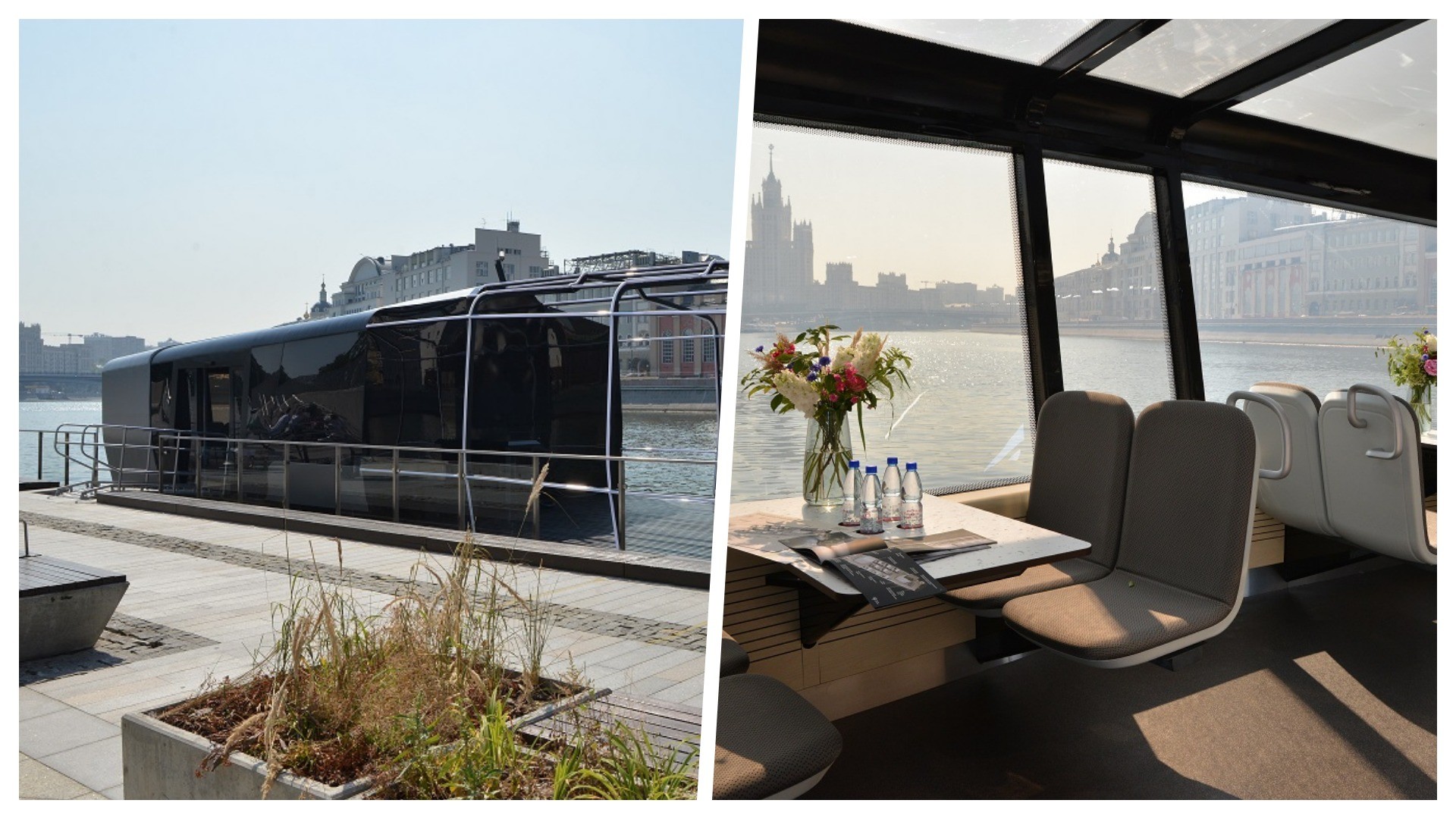
Water transportation has become another sector for the eco-friendly improvements the Moscow government is implementing. And it means business. On July 15, 2021, on the dock of Moscow’s ‘Zaryadye’ park, mayor Sergey Sobyanin was shown the first model of the upcoming river cruise boat.
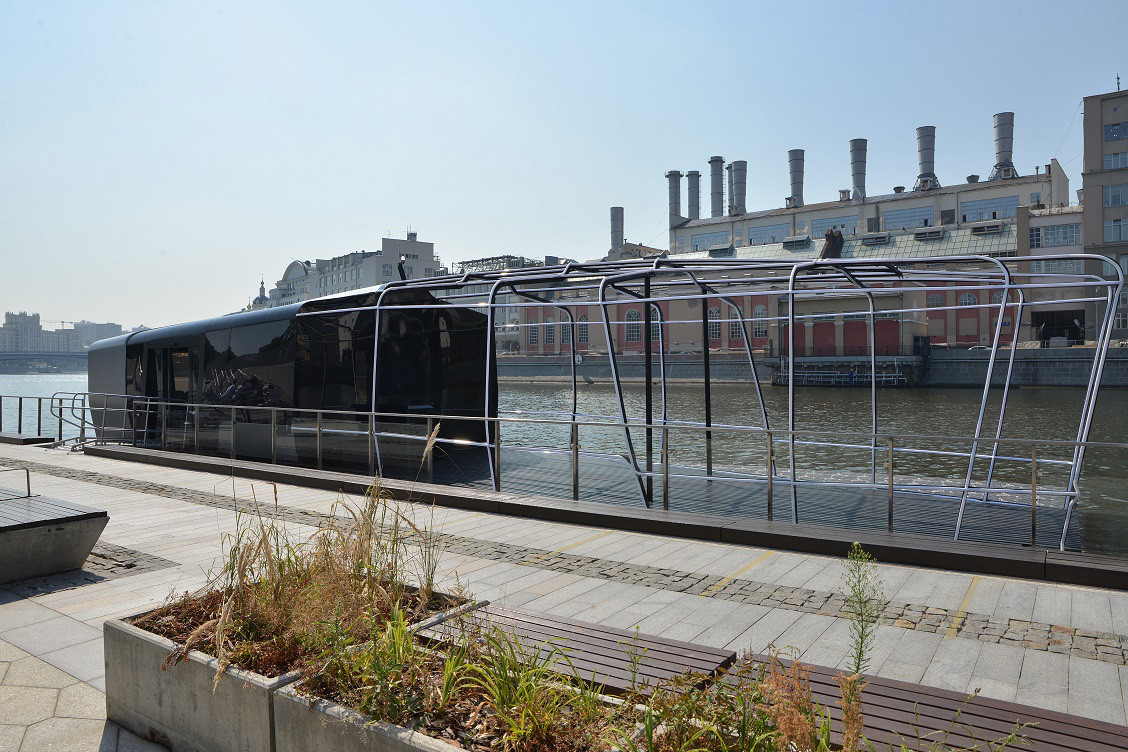
The model of the electrical boat with panoramic windows measures 22 meters in length. The river tram - as Muscovites call them - has a passenger capacity of 42, including two disabled seats. The trams will also get cutting edge info panels, USB docking stations, Wi-Fi, spaces for scooters and bicycles, as well as chairs and desks for working on the go. The boats will be available all year round, according to ‘Mosgortrans’, the regional transport agency.
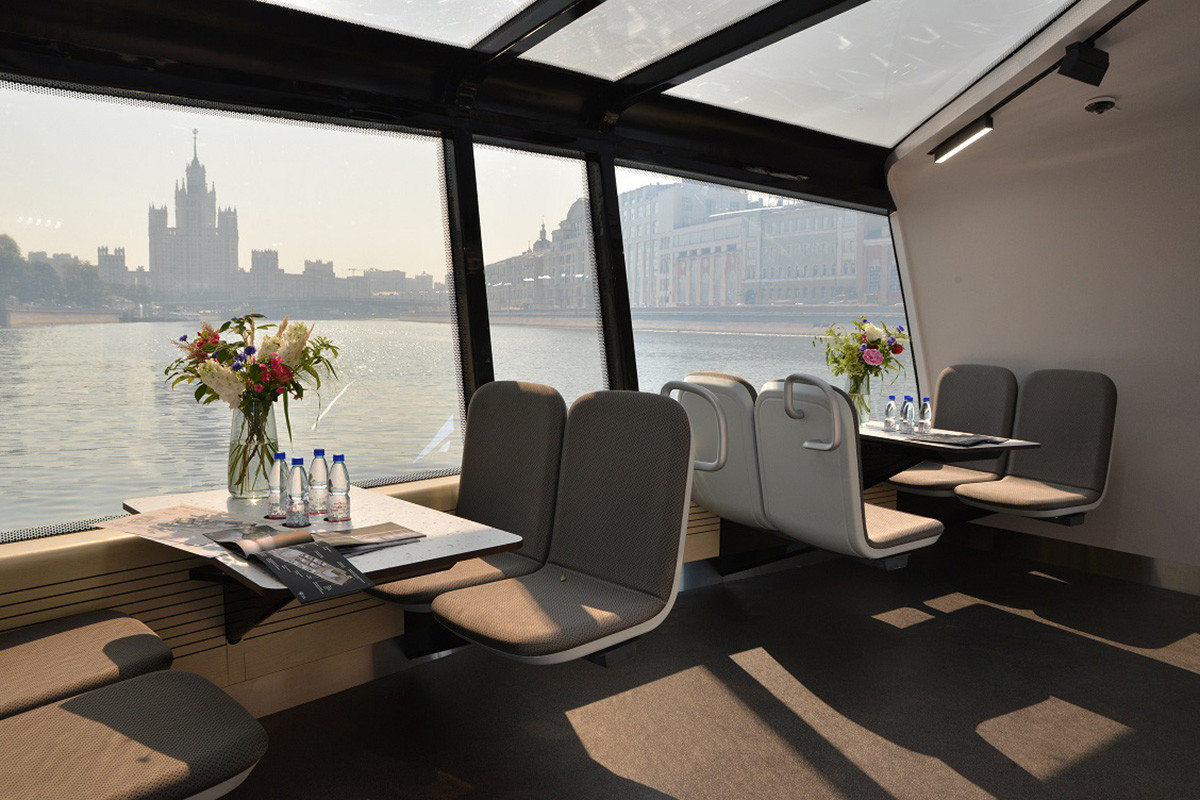
Passengers will be able to pay with their ‘Troika’ public transport card, credit cards or bank cards.
The main clientele targeted are people living in Moscow’s river districts - the upcoming trams will shorten their travel time in comparison to buses and other transportation by five times, Mosgortrans stated.

As the river trams are being rolled out, Moscow docks will also see mini-stations, some of which will also be outfitted with charging docks for speed-charging the boats.
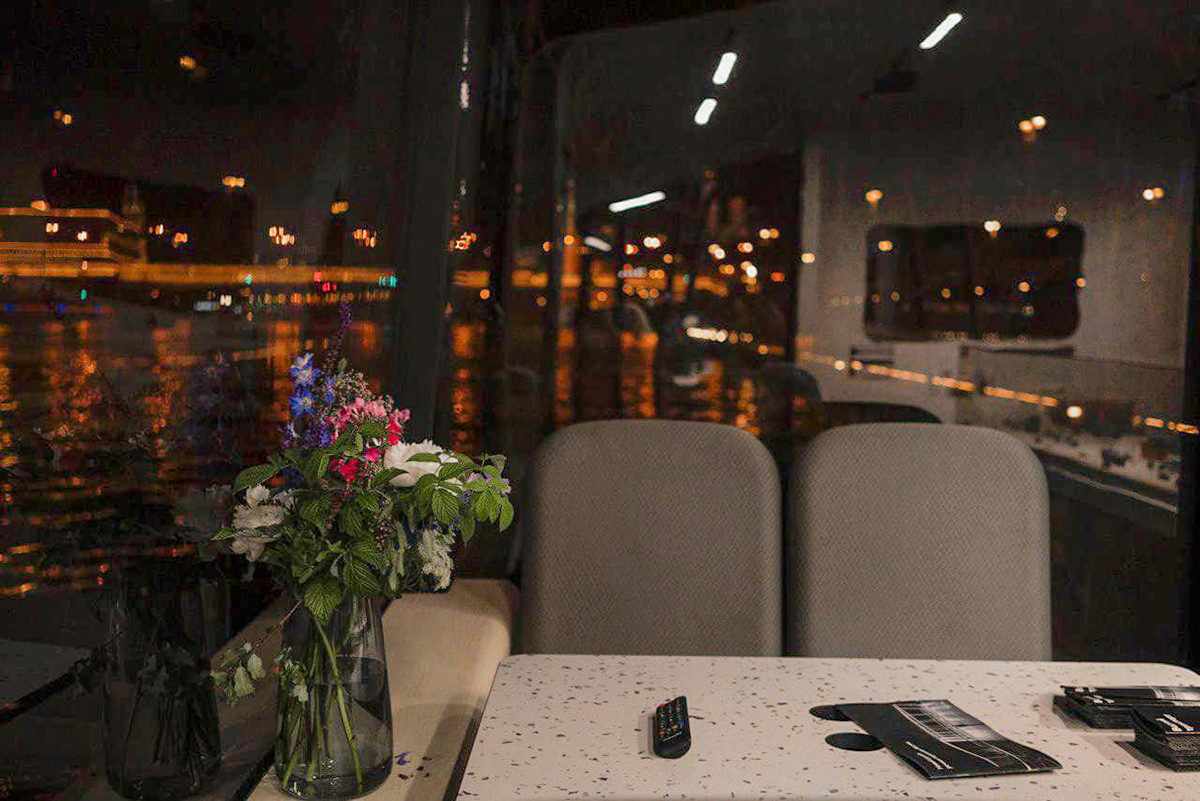
Moscow is set to announce the start of the tender for construction and supply in September 2021. The first trams are scheduled to launch in June 2022 on two routes - from Kievskaya Station, through Moscow City, into Fili; and from ZIL to Pechatniki.
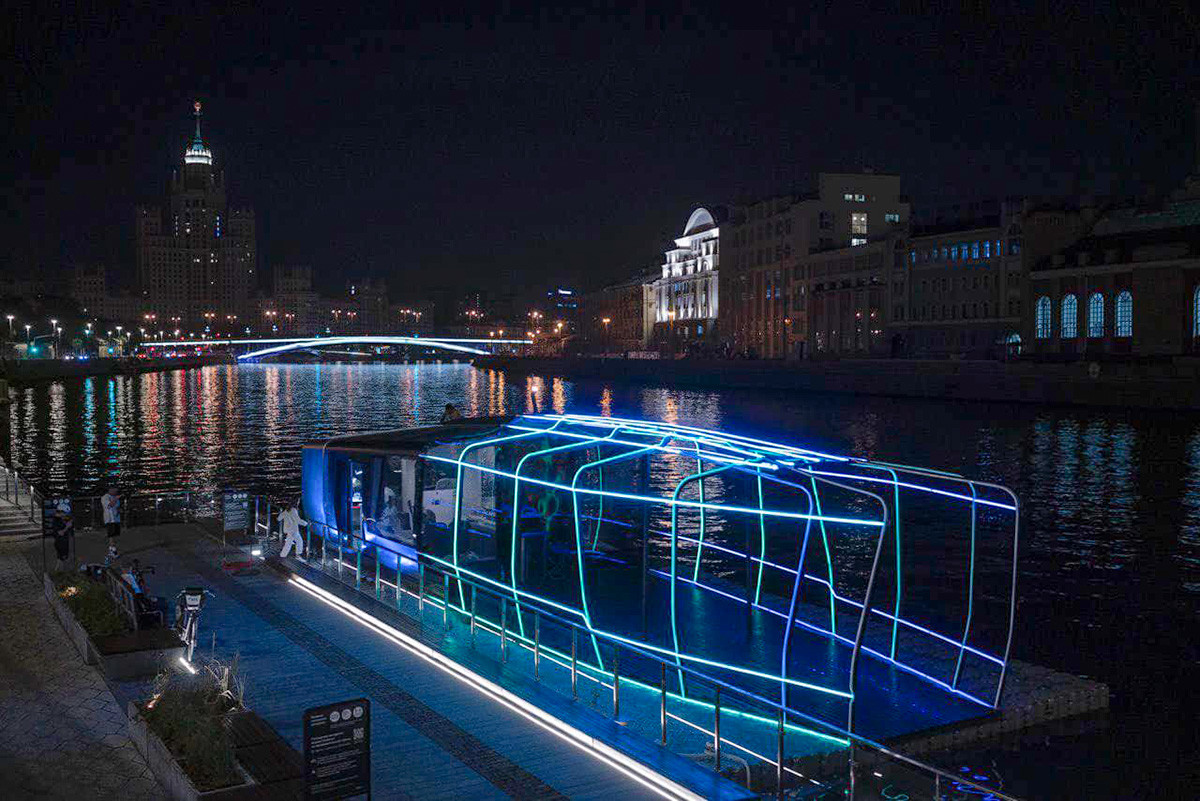
“Two full-scale routes will be created in 2022-2023, serviced by 20 river trams and a number of river stations. We’ll continue to develop them further if they prove to be popular with the citizens,” the Moscow mayor said .
If using any of Russia Beyond's content, partly or in full, always provide an active hyperlink to the original material.
to our newsletter!
Get the week's best stories straight to your inbox
- Face it: Moscow Metro to introduce FACIAL payment technology
- What does Moscow smell like?
- Riding Moscow’s train of tomorrow (PHOTOS)
This website uses cookies. Click here to find out more.

It took 30 years, but world's largest artificial reef built near San Diego nuclear power plant is finally thriving
A n artificial reef built to offset marine life killed by the seawater cooling system at the San Onofre Nuclear Generating Station is finally doing its job, now that the power plant has been shut down for more than a decade.
The reef is essentially an anchor for giant kelp, which grows tall and thick to create the forests of the sea. A form of brown algae, the kelp reaches from the sea floor to the surface, creating a shady tower of shelter for all kinds of fish, spiny lobsters, sea otters, sea lions, sometimes whales and even birds.
Kelp forests provide a habitat for important commercial species of fish such as black rockfish and kelp bass. The slightly slimy ocean vegetable also is used to make a number of human products including shampoo, toothpaste, pharmaceuticals and food.
Scientists knew early on that the nuclear power plant's cooling system would stir up the ocean and degrade nearby kelp beds. They also knew it would vacuum up small fish. However, it took them years of study and collaboration to determine the full effects, design a plan to compensate for that loss, and tailor the plan for the desired results.
The Wheeler North Reef project met its required performance standards for things such as kelp growth and fish production for the first time during the past three years, according to the California Coastal Commission. Now the reef just needs to keep up the good work for another 27 years.
The nuclear power plant, often called SONGS, shut down in 2013 after defects were found in its replacement steam generators. The commission requires the plant's operator, Southern California Edison, to assure that the reef continues its contributions to sea life for as long as the plant operated, a total of 32 years.
"It's great to see this work moving forward ... to meet these restoration goals within these habitats," said Commissioner Justin Cummings at this month's Coastal Commission meeting.
The reef is named for Wheeler J. North, a marine biologist at the Scripps Institution of Oceanography and the California Institute of Technology. North, who died in 2002, was noted for his studies of California's coastal kelp forests.
His namesake reef is north of the power plant, a half-mile offshore and from 38 feet to 50 feet deep, extending 2.5 miles from San Mateo Point to the San Clemente Pier. It's built entirely of rock mined from a quarry and pushed off a barge into the ocean.
As a result of the reef's recent success, this month the commission unanimously approved a program to reduce monitoring, which will save the utility time and money. Instead of monitoring a total of 233 locations across the reef, the utility will be required to check only 166 locations beginning this year.
"A lot of time and effort went into determining what the reduction would look like," said Commission Executive Director Kate Huckelbridge. "Time and cost were factors ... but also that we would still have confidence in the results."
A representative of the Surfrider Foundation said that perhaps it is too soon to scale back oversight.
"This reef failed to meet performance standards for over 10 years," said Mandy Sackett, senior California policy manager for the nonprofit Surfrider Foundation.
"As of 2018, it had never met the standing fish stock requirement, despite the plant being in operation for decades," she said.
"We are grateful to see that the recent reef expansion has significantly increased the amount of times that the reef has met performance requirements, yet we feel strongly that the decades of insufficient performance would indicate a need for continued monitoring at the original frequency, at least in regard to fish stock assessments," Sackett said.
Commission officials said they are confident that the reduced monitoring will be adequate and that it will be returned to former levels if any problems are found.
"There is a lot of confidence that the reduced monitoring is going to be adequate to meet the permit conditions," said Dan Reed, a research biologist at the University of California, Santa Barbara's Marine Research Institute.
UCSB's Marine Research Institute is employed as the reef's independent observer by the Coastal Commission with funding from Edison. Reed has been working on the project since 1993.
Construction of the reef was required by the California Coastal Commission in 1991 to offset the power plant's effects on the marine environment. The commission also mandated the installation of additional barriers on the plant's cooling system to reduce the amount of fish killed by the plant's cooling system and the restoration of 150 acres of Southern California wetlands.
Scientists found that as much as 65 tons of small fish and other sea life were killed every year when they were pulled into the cooling system's 18-foot-wide underwater intakes. The plant used 2.4 billion gallons of seawater daily to cool its steam generators.
Also, when the warm water was returned to the ocean, even though it exited through many holes in a long outlet pipe, the resulting current stirred up sediment and clouded the water. The silt covered and killed marine plants and bottom-dwelling creatures.
In its heyday, San Onofre produced electricity consumed across Southern California, including 20 percent of the juice used by San Diego Gas & Electric Company customers.
SDG&E ratepayers also took on a 20 percent share of the costs of building the power plant, its mitigation projects including the reef and the restoration of the San Dieguito Lagoon in Del Mar, and now the ongoing demolition of the defunct power plant.
Another ongoing cost to ratepayers and taxpayers is the expense of storing spent nuclear fuel at San Onofre. All of the fuel used since the 1980s remains on the site, packed into dry casks and parked at the edge of the ocean.
Initially, the Coastal Commission required a 150-acre reef to be built of low-lying boulders in the ocean north of the power plant near San Clemente.
First, plant operator Southern California Edison built a 23-acre experimental reef and monitored it for five years, Then, based on the results obtained from the experimental reef, Edison completed an additional 152 acres of reef in 2008.
However, the larger reef failed to produce the expected amount of fish, based on estimates of fish populations before the plant was built and compared to two similar natural reefs nearby. As a result, the commission required Edison to build an additional 193 acres, creating what Edison and the State Lands Commission say at a total of 373 acres in all is the largest artificial reef in the world.
Completion of the reef expansion in 2021 finally brought the thriving seaweed beds and fish families that the commission had been seeking for 30 years.
Divers collect data from specific locations, known as transects, to monitor the reef's production. That data is compared to data for two natural reefs nearby in the region, but outside the influence of the power plant.
Each transect measures 3 meters wide, 15 meters long, and 1.5 meters up from the bottom. Initially, the transects were marked with cables anchored into the rock, but today divers use GPS coordinates to find them.
"We dive a lot," said Reed, of the Marine Research Institute, in a recent telephone interview.
Two boats with six to eight divers visit the reef for about four days a week from the end of May through the end of October every year, he said.
"We basically just count fish and kelp, for the most part," he said. However, some of the information needed requires the divers to collect the fish, mainly samples of five key species, and take them to a lab to be autopsied.
Studies of the samples' guts, gonads and eggs help determine how much the fish eat and reproduce. A close look their ears determines age.
"The growth rate can be seen in ear rings, which add a layer of bone each year, much like tree rings," Reed said.
With the information collected the past three years, along with the previous cumulative results, the reef has met its production standards for a total of five years, according to the commission. Now it needs 27 additional years of continued satisfactory marine life production to meet the commission's requirement.
After the results are achieved, the reef probably will remain in place, Reed said. No further monitoring will be required under Edison's permit from the commission.
"To me, it's a success," he said. "We get giant seabass through there ... weighing 400 to 500 pounds, white sharks. It's a functioning reef."
The area is completely open to the public, he said. During lobster season, it's one of the most popular spots for lobster fishing along the Southern California coast.
Well beneath the waves, the reef is only affected by the underwater tidal surge and currents. The rocks were placed in an area of relatively shallow sand supported by a hard substrate, so the reef is unlikely to sink into the ocean bottom. Sometimes ocean currents cover small areas with sand, but they also uncover other areas.
Edison does a sonar survey every five years to measure the actual coverage of the reef, Reed said.
"It's really about what it was when we put it in," he said. "It hasn't changed much at all."
The revised monitoring program should significantly reduce the time needed for diving and lab work, he said. The team will continue to report the reef's status annually to the commission.
This story originally appeared in San Diego Union-Tribune .
©2024 The San Diego Union-Tribune. Visit sandiegouniontribune.com. Distributed by Tribune Content Agency, LLC.

- Water Power Technologies Office
- IRA Tax Credit Opportunities
- Water Power Careers
- WPTO Contacts & Organization
- Water Power Educational Resources
- Water Power Projects Map
- Water Power Strategy & Accomplishments
- How Hydropower Works
- Hydropower Benefits
- History of Hydropower
- Hydropower Glossary
- Pumped Storage Hydropower
- Environmental & Hydrologic Systems Science
- Grid Reliability, Resilience, & Integration (HydroWIRES)
- Hydropower Data Access & Analytics
- Low-Impact Hydropower Growth
- Modernization, Maintenance, & Cybersecurity
- Advantages of Marine Energy
- Marine Energy Glossary
- Foundational R&D
- Marine Energy Data Access & Analytics
- Powering the Blue Economy
- Reducing Barriers to Testing
- System Design & Validation
- Water Power Prizes & Competitions
- WPTO SBIR/STTR Programs
- WPTO Seedling & Sapling Program
- Water Power Publications
- WPTO R&D Deep Dive Webinars
- WPTO Stakeholder Webinars
The U.S. Department of Energy’s Water Power Technologies Office (WPTO) today opened applications for the third annual Hydropower Collegiate Competition (HCC) and sixth annual Marine Energy Collegiate Competition (MECC) . The two competitions engage and educate students about real-world challenges facing these sectors and the many career opportunities in water power with the goal of encouraging the next generation to join the hydropower and marine energy workforces.
Hydropower and marine energy are versatile sources of renewable energy that will play key roles in meeting the country’s clean energy goals. However, these sectors need a skilled and robust workforce to ensure they fulfill that role. The HCC and MECC ask students to develop solutions to complex water power challenges and offer students access to real-world experience and professional connections that can give them a head start in a clean energy career.
“These competitions offer students so many benefits, from resume-boosting experience to industry connections to a chance to envision themselves in a water power career,” said Beth Hartman, WPTO’s Strategic Innovation and Outreach Program Manager. “We hope that participants are challenged and inspired by all the potential in hydropower and marine energy presented through these competitions.”
To give students even deeper connections in the fields of hydropower and marine energy, each competing team will now be paired with an industry mentor. With this new competition component, students will have the opportunity to build working relationships with industry experts who can provide real-world experience, technical expertise, career advice, and other insights into how to navigate the industry.
To apply, competitors must submit a short description of their team, their educational goals, and how they will ensure diversity within their team, among other details. See the official HCC rules and MECC rules for complete submission requirements. Teams do not need to be fully formed to apply; faculty can register by the deadline and finish filling out their teams later. Interested teams can apply through the HCC and MECC websites. Applications for both competitions are due May 6, 2024.
Submissions will be reviewed by a panel of experts, and WPTO expects to notify teams that qualify for the competition in May 2024. Competition activities will begin during the fall semester.
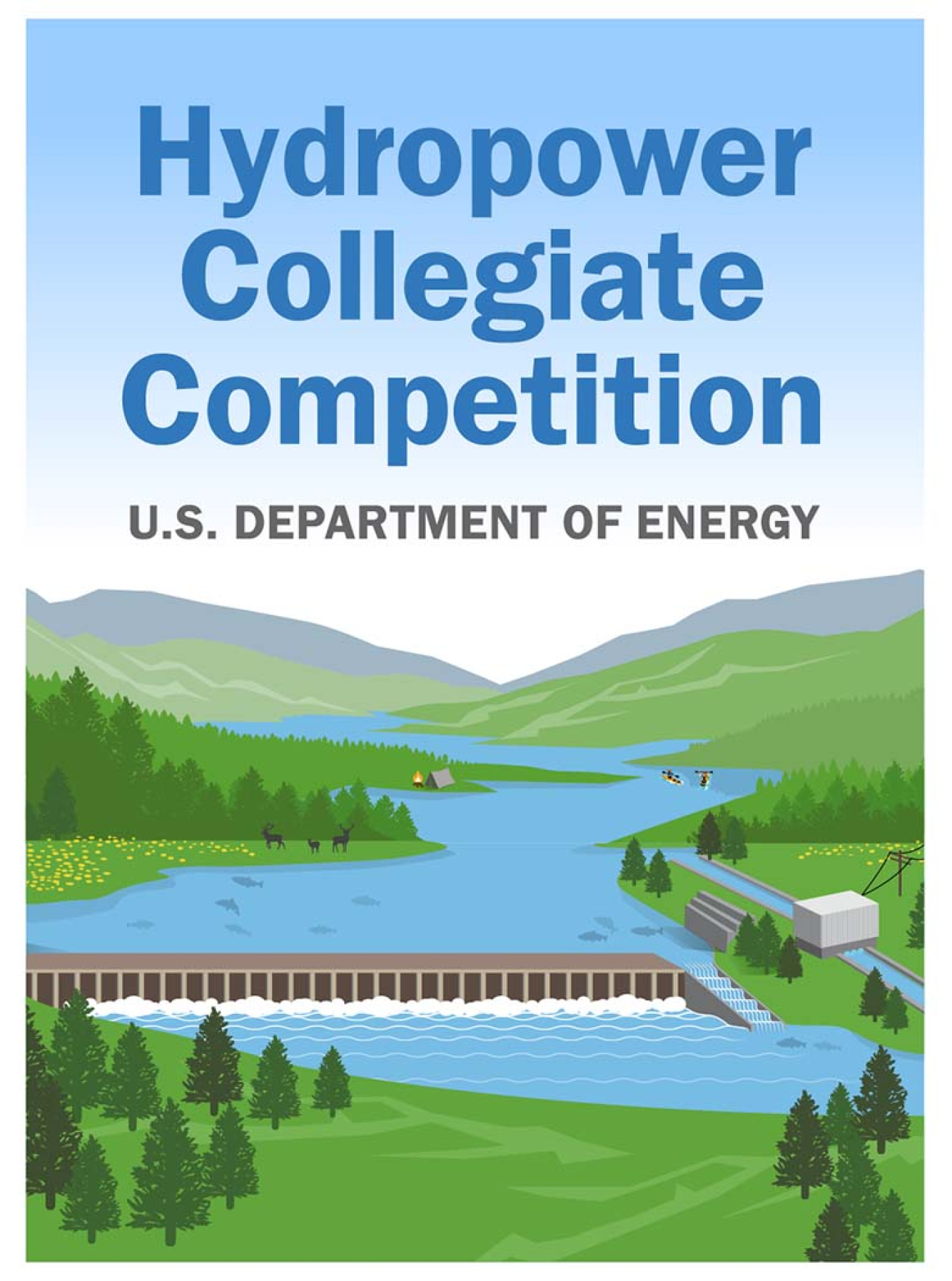
Hydropower Collegiate Competition
During the 2025 HCC, teams will either develop solutions to convert non-powered dams to hydroelectric dams that can produce between 100 kilowatts and 10 megawatts of power or assess closed-loop pumped storage hydropower systems that can provide between 8 and 24 hours of energy storage.
Teams will be required to complete three challenges and may choose to participate in two other optional challenges.
Required Challenges
- The Siting Challenge , where teams perform a site selection process and then develop a feasibility assessment for the selected site.
- The Design Challenge , where teams either create a conceptual design of their selected site or complete a final design for a component or system related to the development of their selected site.
- The Community Connections Challenge , where teams conduct outreach with the hydropower industry and a community of their choosing.
Optional Challenges
- The Build and Test Challenge , where teams build and test a scaled prototype of a component of their hydropower site or system.
- The Cyber in Hydro Challenge , where teams will respond to a case study challenge that involves cybersecurity issues.
Teams competing in all three challenges and who complete all required stages will be eligible for up to $15,000 each in cash awards and will compete for part of the $25,000 grand prize cash pool. Teams competing in the Build and Test Challenge will be eligible for an additional $5,000 cash prize each, and those competing in the Cyber in Hydro Challenge will be eligible for an additional $2,000 prize. The scores that teams receive in the optional challenges will not count toward their overall final score.
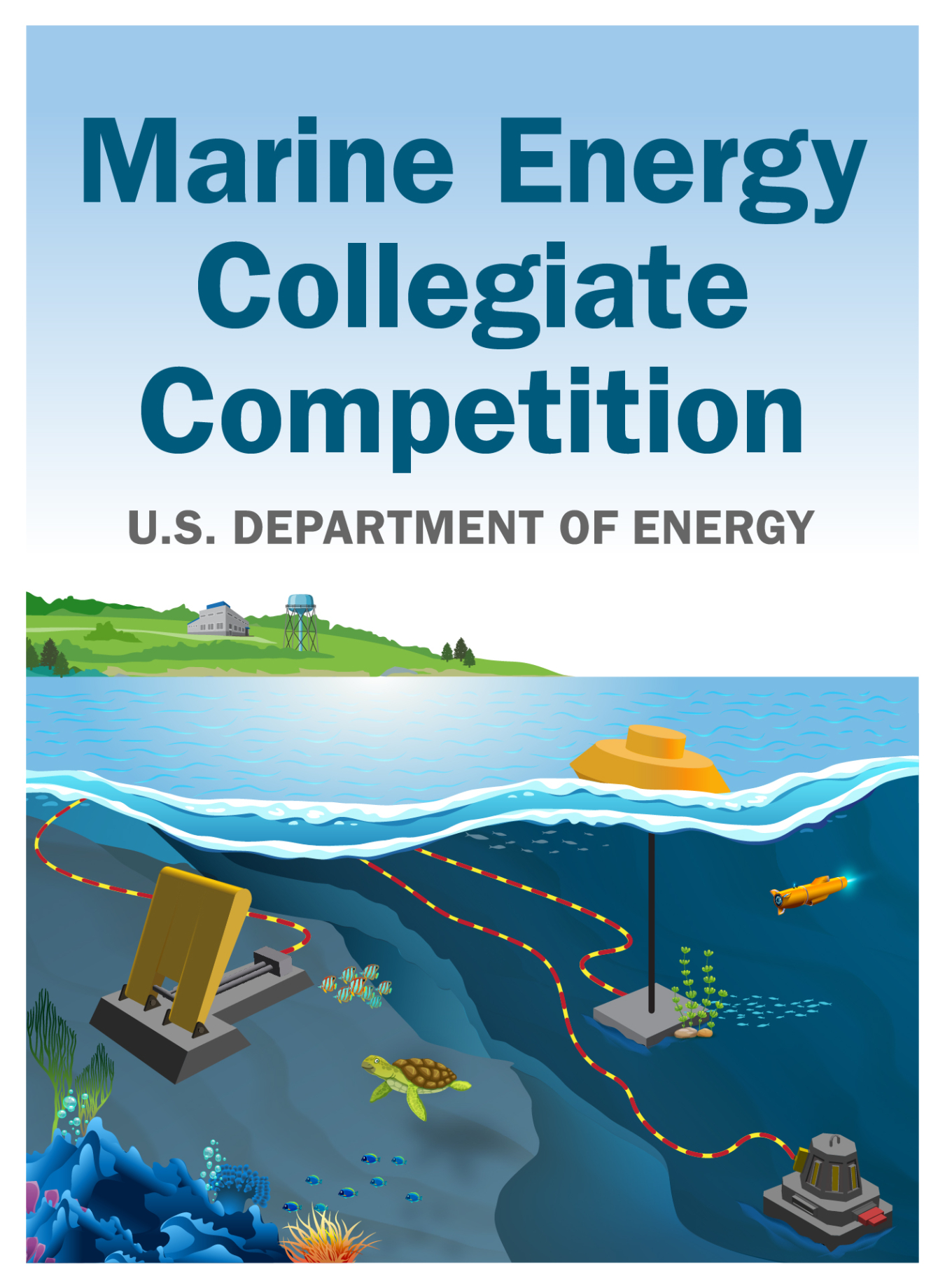
Marine Energy Collegiate Competition
The 2025 MECC asks multidisciplinary teams to integrate marine energy with blue economy applications such as ocean-powered autonomous vehicles, aquaculture, and desalination.
Teams will compete in four challenges:
- The Business Plan Challenge , in which teams identify a promising blue economy market and determine the best marine energy device to serve that market’s needs.
- The Technical Design Challenge , in which teams design a marine energy-powered device to serve consumers within the team’s chosen market.
- The Build and Test Challenge , in which teams build and test a scaled prototype of their concept.
- The Community Connections Challenge , in which teams engage with the marine energy industry and a community of their choosing.
Competing teams that submit all required MECC challenge materials will be eligible for up to $20,000 in total cash awards. They will also be eligible to compete for a part of the $20,000 grand prize cash pool.

Eligibility and Next Steps
Undergraduate and graduate students from post-secondary institutions—including colleges, universities, community colleges, and trade schools—are invited to compete in both competitions. Students from non-U.S. institutions are welcome to apply but are not eligible to receive prizes. HCC and MECC applications do not require initial research or engineering.
While the application period has just begun for the 2025 HCC and MECC, this year’s competitors are prepping for their final events. The 2024 HCC final event will take place in conjunction with the National Hydropower Association’s Midwest Hydro Users Group Meeting in Des Moines, Iowa, on April 29–May 1, while the 2024 MECC final event will happen at Pacific Ocean Energy Trust’s Ocean Renewable Energy Conference in Portland, Oregon, on May 20–23.
Both competitions are funded by WPTO and administered by the National Renewable Energy Laboratory (NREL). The HCC is also administered by the Hydropower Foundation in partnership with NREL.
Learn more about science, technology, engineering, and mathematics (STEM) careers and workforce development opportunities on the Hydropower STEM Portal and Marine Energy STEM Portal .
Sign up for email alerts to keep up with the latest on HCC, MECC, and other water power workforce development news. Or subscribe to the bimonthly Hydro Headlines and Water Column newsletters, as well as the monthly Water Wire newsletter, to receive the latest information on funding opportunities, events, and other news.
About 360,000 households without power as storms batter Northeast
A powerful weather system battered the tri-state area with heavy rain and strong winds over the weekend, as a fast-moving storm blanketed northern New England with snow and plunged some 360,000 households in the Northeast into blackouts.
At 6 a.m. ET Sunday, more than 197,000 households in Maine, 81,000 in New York state, and 73,000 in New Hampshire were without power, according to PowerOutage.us , which aggregates live outage data.
“Keep you and your family safe if you lose power,” Robert Buxton, director of the New Hampshire Department of Safety’s Division of Homeland Security and Emergency Management, said Saturday night. “Crews are out and working hard to restore outages as they happen. If you come across downed wires, stay away and call 911.”
He recommended staying updated with phone alerts or by radio broadcast, using flashlights rather than candles for emergency lighting, and refraining from using gas stoves or ovens for alternative heat.
By Sunday morning, footage showed the Northeast blanketed in snow, down trees in New York City, and flooded roads and highways across the region.
The New York City metro area through central and southern New Jersey received between 2 and 3 inches of rain on Saturday. Though the storm had cleared by Sunday morning, the National Weather Service warned of continued wind chills in the teens and 20s.
A swath of the Northeast received heavy snowfall. As of Saturday, 8:30 p.m. ET, 24.5 inches of snow had fallen on Landgrove, Vermont, 20.5 in both Corinth, New York, and Claremont, New Hampshire, and 13.5 in Sweden, Maine, according to the National Weather Service .
By 2 p.m. ET on Saturday, Philadelphia had recorded 3.06 inches of rainfall, making this the wettest March since the state began keeping records in 1872.
Weather conditions caused major delays across New York City airports. Arrivals at John F. Kennedy International Airport were delayed an average of three hours as of 5 p.m. EDT, according to the Federal Aviation Administration . La Guardia Airport also experienced delays in arrival and departure flights.
Elsewhere, a fast-moving storm dumped snow across parts of northern New England. More than 30 million people from the northern Rockies and Upper Midwest through the central Great Lakes into New England were under winter alerts.
Light to moderate snow was expected for the Upper Midwest to the Great Lakes, where 2 to 7 inches was forecast.
The Maine Emergency Management Agency said the storm could bring the largest snowfall of the season and urged motorists to use caution.
“Mixed precipitation in some areas will make for especially hazardous travel conditions,” the agency said in a post on X . “Check your local forecast for conditions.”
In the Twin Cities area, the storm was predicted to bring more than 12 inches. Combined with a 2.9-inch accumulation from a “teaser” snowstorm Thursday night and Friday morning, snow totals were forecast to exceed the 14.3 inches that had fallen in the previous season.
Meanwhile, a storm behind it swept down the California coast as it moved east, bringing 0.5-1 inches of rain to the Bay Area. More than 6 inches of snow was also recorded in the Sierra Nevada range, with the Heavenly Lake Tahoe resort reporting 10 inches of fresh powder Saturday morning.
In Oxnard, a city along the coast northwest of Los Angeles, a reading of 0.59 inches of rain set a modern record for this date. Same for Lancaster, a high desert city in Los Angeles County, which measured 0.53 inches of rain.
Orange and San Diego counties posted mostly smaller fractions of an inch of rain by the time the bulk of the storm passed Saturday evening.
The same front was moving east and forecast to bring “heavy snow and strong winds, and possible blizzard conditions to the Northern Plains and Upper Midwest through Tuesday morning,” the National Weather Service said in a forecast discussion.
From Kansas to Texas, the storm could churn up scattered severe thunderstorms on Sunday, the weather service said.
Minyvonne Burke is a senior breaking news reporter for NBC News.
Madison Lambert is a freelance assignment editor at NBC News.
Katherine Itoh is a news associate for NBC News.
Watch CBS News
The April 8 solar eclipse could impact power. Here's why.
By Caitlin O'Kane
March 18, 2024 / 10:50 AM EDT / CBS News
The upcoming solar eclipse on April 8 will darken the sky for millions as the moon passes in front of the sun – but the spectacle could also affect how much solar power gets generated.
The Electric Reliability Council of Texas, known as ERCOT, which provides solar service to 90% of the state, says the event will affect solar production in Texas between 12:10 p.m. and 3:10 p.m. CDT while the eclipse passes over the state from the southwest to the northeast.
"ERCOT is working on forecasting models to reflect solar generation on the grid during the eclipse," a representative for ERCOT told CBS News via email. "ERCOT does not expect any grid reliability concerns during the eclipse. ERCOT will use all available tools to maintain grid reliability and will continue to monitor conditions and keep the public informed through our communications channels."
Solar power accounts for about 3.9% of the energy generated in the U.S. in 2023, according to the U.S. Energy Information Administration. In Texas, solar energy accounted for 6% of the energy generation in 2022, according to ERCOT.

Due to its generally sunny weather, Texas is the second-largest solar producer in the U.S., after California.
During the 2017 eclipse, California prepared for solar power outages, with state agencies urging people to cut back on power use during the event.
ERCOT, however, hasn't asked people to reduce power use during the eclipse, the representative said.
Utilities and grid operators across the U.S. prepared for the possibility of a drop in solar power during the 2017 eclipse as well. Standby power sources were lined up and simulations of the potential impact were run, according to Reuters.
But analysis from the National Renewable Energy Laboratory found the 2017 eclipse didn't cause any issues to the operation of the North American electric power system.
The April 8 solar eclipse will start on Mexico's Pacific coast at around 11:07 a.m. PDT. It will then travel across parts of the U.S. and into Canada and will leave continental North America at 5:19 p.m. EDT.
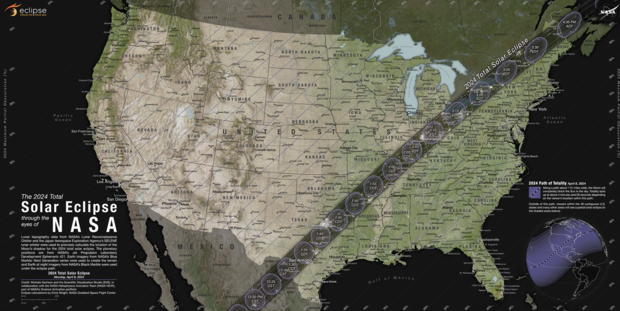
About 31.6 million people live in the 200-mile path of totality — the path where the total solar eclipse will be visible, according to NASA . For the 2017 eclipse, an estimated 12 million people were able to see a total solar eclipse.
All areas in the path of totality of the April eclipse could see their solar power affected, said Hugh Cutcher, a data scientist for Solcast, a solar forecasting and data company.
Texas, however, is expected to see the biggest impact, losing up to 16% of their daily irradiance, or solar energy, according to Cutcher. "The fast change in generation is what can cause instability in the grid, so asset managers, energy traders and the grid operators will be working to maintain stability whilst making the most of volatile energy prices," Cutcher writes.
On the East Coast, which uses less solar power than Texas, the eclipse is expected to have a smaller impact. But rooftop solar panels could be effected, and New York Independent System Operator, which runs New York's solar power grid, could see a 10.9% drop in solar generation from these rooftop panels, according to Cutcher's analysis.
NASA says the eclipse can also cause temperatures to drop. In 2001, a solar eclipse caused the temperature to drop nearly 15 degrees in Lusaka, Zambia, because the sun's warmth is blocked out by the moon. But NASA says the coolness might not even register on thermometers because the daylight will return in about two to three minutes.

Caitlin O'Kane is a New York City journalist who works on the CBS News social media team as a senior manager of content and production. She writes about a variety of topics and produces "The Uplift," CBS News' streaming show that focuses on good news.
More from CBS News
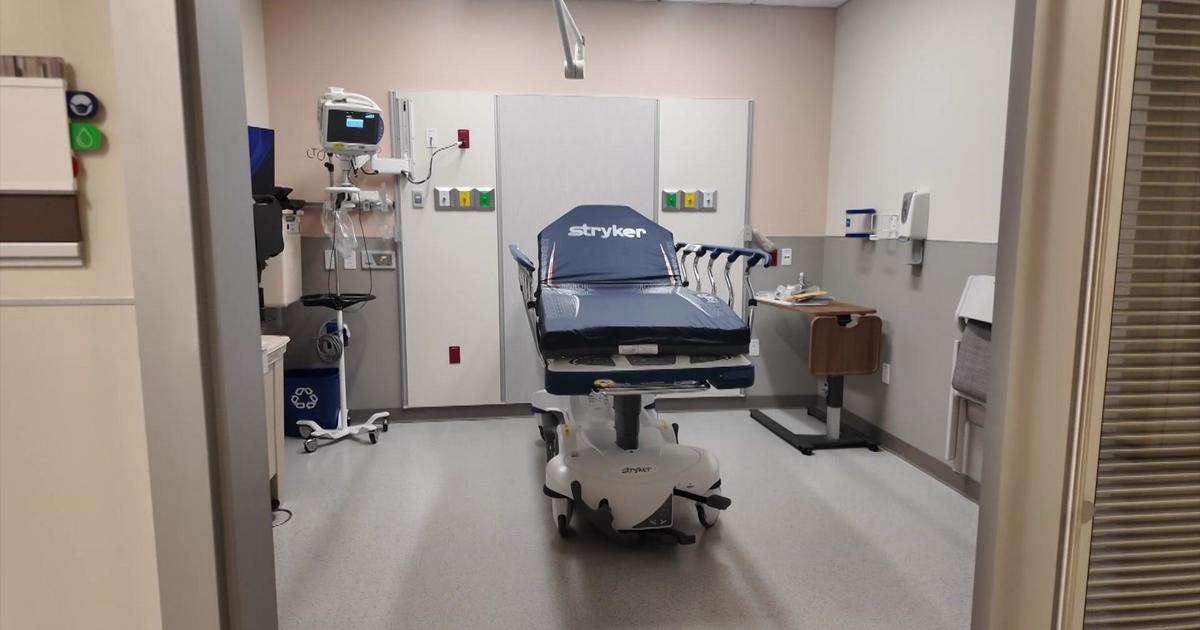
Ridgewood's Valley Hospital moving to new facility in Paramus in April

Man accused of running illegal shelters sublets Queens home to migrants

Yonkers' St. Patrick's Day Parade postponed due to rain

Lustgarten Foundation's NYC Walk for Pancreatic Research set for April 21, 2024

IMAGES
VIDEO
COMMENTS
The system is based on DCL International's Marine-X system, which removes particulates as they are emitted from the engine. Throwing a wrench into the development of diesel-electric yachts are ECAs, or Emission Control Areas. These areas are intended to cut down on NOx (nitrogen oxides) and SOx (sulphur oxides) null.
The 2011 introduction of a marine version of the highly successful BAE Systems' HybriDrive terrestrial drive system by Northern Lights, the Seattle-based manufacturer best known in the yacht market for its marine generator products, may provide a glimpse into the future of superyacht electrical power.
AutoSHORE 30. Atlas Marine Systems has electrical power systems and shore power systems available for almost any yacht or boating need boat owners may come across. From on-board frequency converters and electrical distribution systems, to dockside power converters. Either way, providing a cleaner, more efficient power conversion and power ...
One example of a power system commonly used on green yachts is solar power. Photovoltaic (PV) panels can be installed on the deck or superstructure of the yacht to convert sunlight into electricity. Another example is wind power, where wind turbines are mounted on the yacht to generate electricity. Another popular power system on green yachts ...
Which system to use, and the power levels, ranges, and efficiencies that are possible will depend on a number of variables including the type and use of the yacht, and owner preference. Whatever the type of system in use, the end goal is to deliver the most efficient operations possible, making use of all systems and of available electrical energy.
The world's third largest boatbuilder, Hanse Yachts, is perhaps the most advanced - offering its entry-level Hanse 315 with an electric rudder-drive option. The system takes up less space than ...
Advantages of our Hybrid Propulsion for Yachts. Significant savings on fuel consumption. Drastically reduce main engine and variable speed generators running hours. Savings on scheduled maintenance. Our hybrid yacht propulsion system is maintenance free. Only the dedicated water cooling pumps require service. Higher resale value of your vessel.
The power of a diesel engine, which allows top speeds, is combined with the sustainable, emission-and vibration-free comfort of an electric drive. The highlight, in addition to fuel and cost savings, is that with a hybrid system, yacht owners can explore waters previously off-limits to diesel drives with a clear conscience.
Reliability is at the heart of ASEA Power Systems. We pride ourselves on delivering unparalleled reliability, ensuring that our customers have a seamless and secure connection to shore power no matter where their journey takes them. Our products are trusted by yacht owners, marinas, and shipyards worldwide.
TPA switchboards are suitable for any size of yacht with small single phase boards to three phase high voltage 2000 amps systems. Sophisticated Power Management. The TPA system is available with various degrees of automation and power management. Motor operated circuit breakers enable push-button or touch screen selection of power sources.
This means they likely have one or two house batteries to power 12V systems. There is really no need for an AC electrical system in this case. In comparison, larger boats such as yachts or catamarans will usually have a house electrical system in addition to the DC power system. To power these crafts fully, you'll need AC power.
The ShorPOWER ® SHP ™ series of frequency converters are designed to be the workhorse of the marine industry. Unlike other converters available they are built from a single power module of up to 200kVA that can be paralleled to create a system up to 2.0MkVA. This converter is highly reliable and is designed to provide years of service of ...
Converting power from the main battery to support various onboard loads is a crucial aspect of re-powering a yacht with an electric propulsion system. With a 48V DC system, it is simpler and more cost-effective to convert power to the commonly used 12V DC for house loads, such as pumps, lights, cockpit instruments, and radios.
Marine Shore Power For Yachts Of All Sizes. Atlas Marine knows yachts come in all shapes and sizes, and we provide frequency converters to fit them all. Our converters are based on KVA ratings and range from single power modules of 37.5 kVA to 200KVA, with ability to parallel systems and get all the way up to 1MVA.
performance components. We are committed to providing premium marine parts and accessories, compatible with all boat types and meeting the highest industry standards. Navico Digial Systems power your marine adventures and protect your boat's electrical systems. Learn more about our cutting-edge marine technology.
Do you find marine power systems confusing? Are you trying to determine if your boat has enough power to run the equipment you'd like to install? In Part 1 o...
The house battery stores power for the boat's electrical system. Sailing yachts typically have long intervals between battery recharges and the house battery should have a generous capacity. For a house battery you can choose from two types: lead-acid and lithium. There are various reasons to favour one over the other. Here are a few common ones:
Yacht Electrical Systems - Basic Overview & Useful Resources. Dimitris Tsapis. January 8, 2022. Yacht electrical systems are often overlooked. This can come from intimidation, lack of knowledge, or fear of accidents. For the most part, however, it is the result of lacking the expertise to deal with issues that arise.
Marine Engines and Power Systems: The Basics Behind What Powers Your Powerboat. Outboard engines, inboards, pod drives, jets, V drives, diesel, and gas—we'll help you understand all the types of motorboat engines on the water. Boat engines take many shapes, sizes, and forms, ranging from the common outboard to rarely seen surface drive ...
With deep expertise in marine and naval performance requirements, GE Vernova's Power Conversion UK center of excellence (COE) will be responsible for the design, systems engineering, manufacturing and testing of the equipment. ... 100+ countries around the world. GE Vernova's Power Conversion business provides energy conversion technologies ...
Private equity firm Carlyle Group Inc. is preparing to enter advanced negotiations to acquire a majority stake in Thyssenkrupp AG's naval shipbuilding unit in a deal that could value the ...
Walking tour around Moscow-City.Thanks for watching!MY GEAR THAT I USEMinimalist Handheld SetupiPhone 11 128GB https://amzn.to/3zfqbboMic for Street https://...
On July 15, 2021, on the dock of Moscow's 'Zaryadye' park, mayor Sergey Sobyanin was shown the first model of the upcoming river cruise boat. The model of the electrical boat with panoramic ...
An artificial reef built to offset marine life killed by the seawater cooling system at the San Onofre Nuclear Generating Station is finally doing its job, now that the power plant has been shut ...
The U.S. Department of Energy's Water Power Technologies Office (WPTO) today opened applications for the third annual Hydropower Collegiate Competition (HCC) and sixth annual Marine Energy Collegiate Competition (MECC).The two competitions engage and educate students about real-world challenges facing these sectors and the many career opportunities in water power with the goal of encouraging ...
It includes 103,142 kilometres of power networks, 158 power centres and 20,093 transformer and distribution substations. ... After reconstruction in 2017, it increased its power to 952 MVA. Now the city's power system is ready for the 2018 FIFA World Cup. Among other consumers of the Presnya substation are the Moscow Zoo, the World Trade ...
The Shahed-model drone that killed three U.S. service members at a remote base in Jordan on Jan. 28 cost around $20,000. It was part of a family of drones built by Shahed Aviation Industries ...
The outage lasted from 9:50 a.m. to 12:30 p.m. ET, AAMVA spokesperson Claire Jeffrey said. "During that time, there was no ability to process messages that support transactions of driver licenses ...
At 6 a.m. ET Sunday, more than 197,000 households in Maine, 81,000 in New York state, and 73,000 in New Hampshire were without power, according to PowerOutage.us, which aggregates live outage data.
The solar eclipse will impact solar production in Texas between 12:10 p.m. and 3:10 p.m. CDT. But the power grids are expected to be reliable.